

to surprising
CROATIA

Pozdrav!
It’s always tempting to squeeze in as much as possible on our travels, especially in a country like Croatia where there is simply so much to pack in. Visitors will discover more than more than 1,200 islands, thousands of kilometres of hiking and biking trails, ten UNESCO World Heritage sites (not to mention the 22 UNESCO Intangible Cultural Heritage listings), centuries of history, sprawling coastlines, forests and mountains, museums, art galleries… the list goes on. But, much like its underrated wines and farm-fresh food scene, this is a country that is best savoured slowly. Take the time to take it all in and you will have the chance to experience a lesser-seen side of Croatia: one where you can get to know the local people and learn about their traditional crafts in quiet villages or on uncrowded islands.You’ll stroll or cycle between vineyards, or even pause to help harvest the grapes. You’ll uncover alternative UNESCO sites that are blissfully free of people and set sail on the Adriatic to find secret beaches that you’ll likely have all to yourself. This is the Croatia that you don’t know about. Join us as we uncover this captivating country’s surprising side.
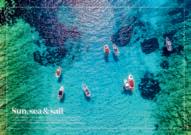


Editor-in-Chief George Kipouros Founding Editor Lyn Hughes
Writers Rudolf Abraham; Richard Mellor; Mary Novakovich; Tristan Rutherford; Ellie Swain; Rachel Truman Special Features Managing Editor Rosie Fitzgerald Regional Editor Laura Field Associate Editor Gareth Clark North America Editor Jacqui Agate Senior Digital Editor Dianne Apen-Sadler Art Director Graham Berridge Digital Creative Director Todd Padwick Digital Specialist Tom Bennedik Digital Designer Lisa Huang Chief Commercial Officer Adam Lloyds VP Brand Partnerships David Read VP Destination Partnerships James A Smith Chief Operating Officer Elliot Wellsteed-Crook Wanderlust Club Manager Maria Manta Illustrator Karen Katon-Oprey (wearehark.com)
© Wanderlust Travel Media Ltd, 2025
Published by Wanderlust Travel Media, Capital House, 25 Chapel St, Marylebone, London NW1 5DH. All rights are reserved. Reproduction in any manner, in whole or in part, is strictly forbidden without the prior written consent of the publishers. All prices are correct at time of press. No responsibility for incorrect information can be accepted. Views expressed in articles are those of the authors, and not necessarily the publishers. Wanderlust is a registered trademark.

Hidden delights (opposite page) The bell tower of the Church of Saint Mark rises above the harbour on the main on Hvar, an island of stories, traditions and unique crafts that most visitors never see; (front cover) The ancient stone walls of Korčula stand as a timeless guardian, preserving the town’s heritage




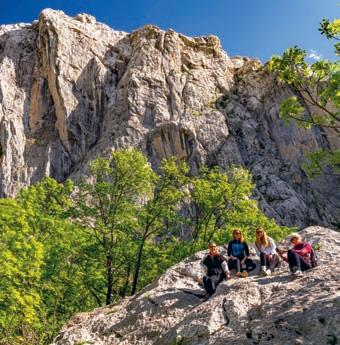

Sun, sea & sail
14
Mesmerising marine parks
From dazzling dive sites to glittering night skies, we round up five wild places on Croatia’s coast that truly shine
18 Secret sands: Five lesser-known beaches
Little beats having a secluded slice of shoreline to yourself. We reveal some of Croatia’s finest hidden shores
20 Trip planner: Set sail in Croatia
With more than 1,240 islands to pick from in Croatia, it can be hard to know where to start planning a sailing adventure. Our comprehensive trip planner shows the way
Culture
26
Come rain or sun… Croatia’s culture always shines
With a rich history of art and creativity, Croatia’s cultural institutions offer some incredible days out, whatever the weather
28
Meet the locals: The north
We speak to some of the people who call Međimurje and Zagorje home to find out what makes these neighbouring northern regions of Croatia so special
30 Off-season Dubrovnik
The local people of Dubrovnik reveal the perks of visiting this popular medieval city when the crowds have died down
32 UNESCO sites minus the crowds
We reveal four of Croatia’s least known yet still spec tacular World Heritage sites
33 Cultural calendar Croatia is a country that comes alive with cultural events throughout the year. Here’s just a taste of what to expect and experience each month

Nature

The bear necessities: A frolic in the forests of Gorski Kotar
Find out how you can spot brown bears and other spectacular wildlife in a region rightly known as Croatia’s ‘green heart’
Hiking highs
Wild Croatia is a country best explored on foot. Read our guide to some of the country’s finest cliff, coast and mountain walks to start planning your next nature-filled escape
Cycling in Slavonia
Follow in the tyre tracks of our intrepid writer as he explores one of the most exciting new cycling routes crossing into Croatia: the Amazon of Europe trail
Gastronomy
48 A gourmand’s guide to Croatia
Discover a country blessed with a bounty of fresh produce from sea and land
50
A flavour of the Med
Plan a trip to delight the taste buds with our full guide to Croatia’s Mediterranean culinary scene
52
At the chef’s table: In conversation with Bernard Korak
Wanderlust’s editor-in-chief, George Kipouros, visits the Michelin-starred Korak restaurant in the Plešivica region to catch up with its co-owner and chef, Bernard Korak, on the importance of family and farm-to-table fare
53 Sand, sea and salt in Pag
We dive into the salt-making heritage of the island of Pag and reveal how you can learn more about the production of its ‘white gold’
54
On the trail of the vine
Savour the Slavonia region by slowing down and sipping a glass or two of wine at the many vineyards found here
56
The joy of slow food
Croatia is all about taking it slowly – and the same goes for its food. We look at how to explore its exciting slow-food scene

Coastal escapes
60 Hidden isles
Can you keep a secret? We reveal five of Croatia’s little-known islands so you can explore in uncrowded bliss
62 History and heritage in Hvar
Locals on Hvar explain the importance of keeping alive the traditions, artisanal crafts and stories of an island that is unusually rich in cultural heritage
66 Slow down in Šibenik
Find out how you can ease into the local pace of life in this history-rich region bursting with cultural delights, including a historic cathedral, local festivals, fresh food and so much more…
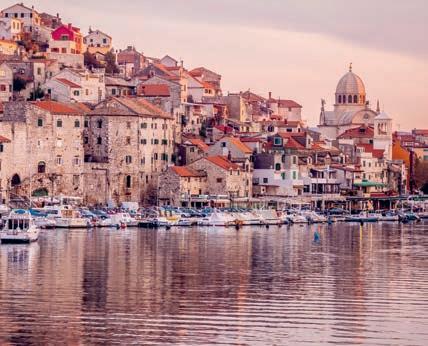
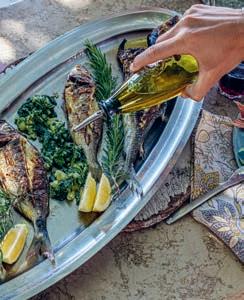
Destination guides
74 Zagreb
Croatia’s cool and classy capital is too often skipped over by travellers. Explore its highlights, hidden delights and in-the-know attractions
76 Međimurje
Dive into a region in northernmost Croatia that remains far off the tourist radar to discover a wealth of authentic local experiences
78 Gorski Kotar
Wild scenery, great walks and wonderful emptiness await in this lush, mountainous region
80 Slavonia
Prepare to be captivated by easternmost Croatia’s collection of culture-filled cities and towns, as well as its sprawling wetlands


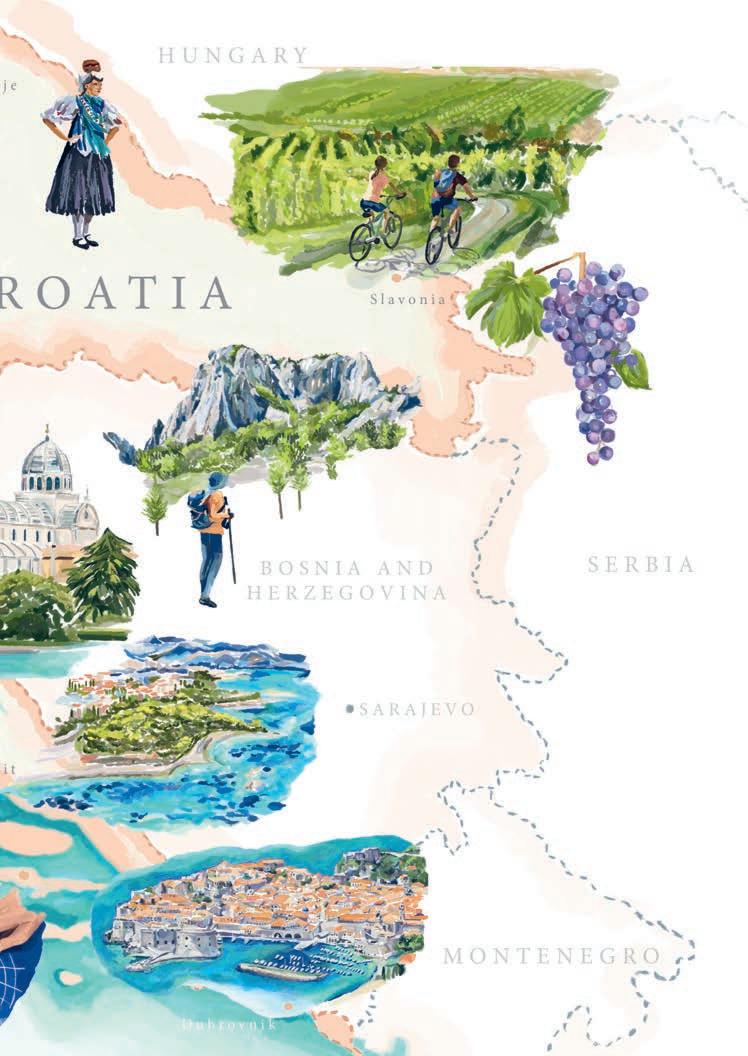

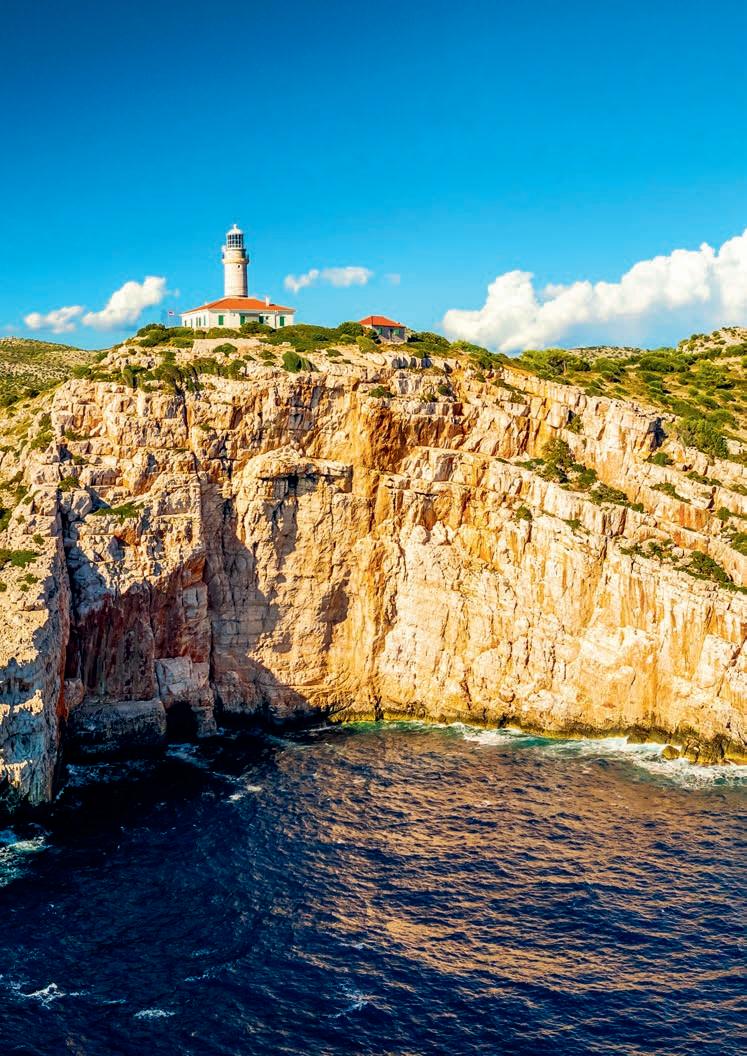
Lastovo Island, Central Dalmatian archipelago
Photographer: Julien Duval
It’s easy to escape the crowds and feel entirely alone in Croatia. Head to the southern side of the island of Lastovo, and you will see the Struga Lighthouse looking out over the lonely sea surrounding the Lastovo archipelago nature park. Despite its remote location, Lastovo is inhabited. Out of Croatia’s 1,244 plus islands, fewer than 50 of them have permanent residents.


Skradinski Buk, Krka National Park
Photographer: Julia Lavrinenko Krka National Park is a waterfall wonderland packed with thundering cascades to feast your eyes on. But perhaps the most impressive of the lot is Skradinski Buk, the longest tufa barrier in Europe. It’s best soaked up on foot, and you can follow a 2km-long trail looping around the waterfalls, looking out for the flora and fauna that thrives here along the way. If you’re lucky, you may even catch sight of the resident otters.
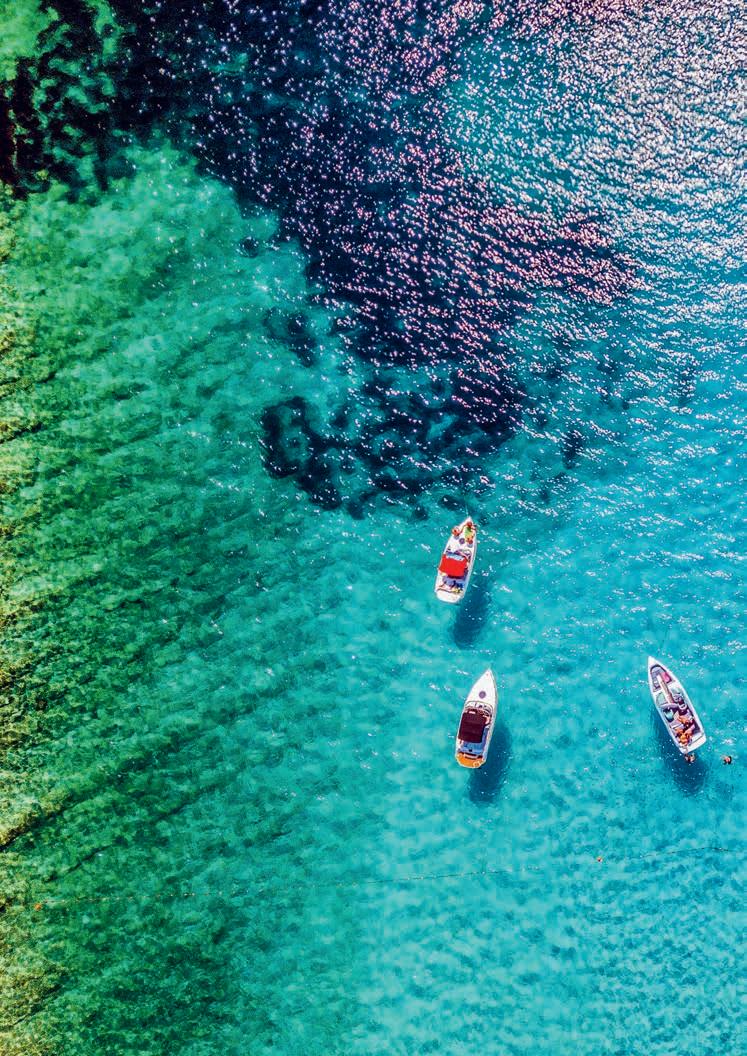
Sun, sea & sail
Croatia’s vast coastline truly glitters. Discover how to set sail on the Adriatic, where to marvel at the country’s wondrous marine parks and the secret sandy shores that only locals know about from those who know this coast best
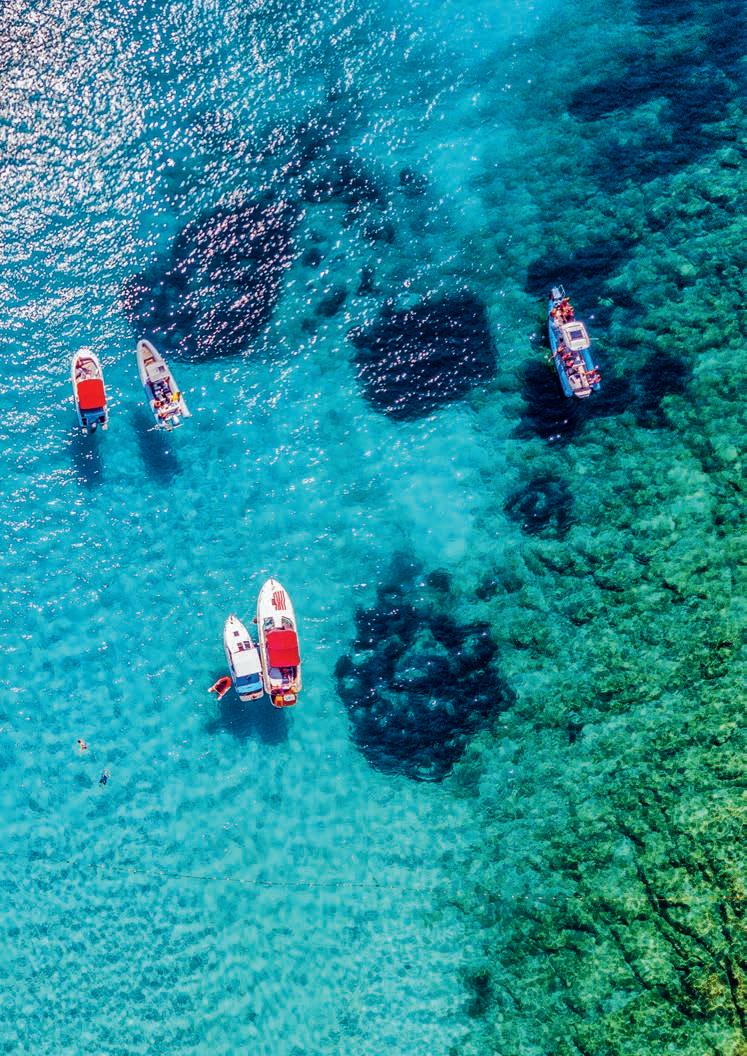



Mesmerising natural wonders
From dazzling dive sites to glittering night skies, Croatia’s nature parks truly shine. Mary Novakovich reveals how best to explore them…
Croatia’s Adriatic Sea is one of the glories of the Mediterranean. For an introduction to some of the island jewels scattered along this sparkling coast, head for the marine parks, which show off Croatia’s beauty, fascinating culture, compelling history and, at times, downright quirkiness. It truly is a voyage of discovery.
LASTOVO NATURE PARK
One for lovers of the stargazing, Lastovo Nature Park is Croatia’s remotest inhabited archipelago. Lastovo is so rich in birdlife and natural beauty that the entire archipelago – including 46 islands and islets – was declared a nature park in 2006.
Life runs at a slower pace here. Have a waterside lunch in Zaklopatica Bay on the main Lastovo island, or head for a lazy swim in the aptly named Skrivena Luka (which means hidden harbour). There is always something to do, such as exploring Lastovo’s marine world on a diving trip to Sušac island or taking a boat to the sandy shores of Saplun. You’ll fall under the spell of Lastovo island’s ink-black skies on a guided nighttime visit to
its highest point, Mount Hum (415m). And because Lastovo was once an army base, cut off from tourists until 1989, you can spot old submarine tunnels and bunkers.
BRIJUNI NATIONAL PARK
There’s quirky, and then there’s Brijuni National Park. Take the ferry from the Istrian village of Fažana to Veliki Brijun, the largest of the 14 islands and islets in the archipelago. The mix of history here is captivating: ancient Roman and Byzantine ruins mingle with the legacy of the 19th-century industrialist Paul Kupelwieser, who turned the island into an aristocrat’s playground. When Yugoslavia’s former president Josip Broz Tito first clapped eyes on Brijuni after the Second World War, he created a lavish summer residence to entertain world leaders and celebrities. Wander the safari park to meet descendants of the animals gifted to Tito, then learn about the president’s heyday in the museum.
Hire a bike or electric buggy to explore forested trails and pebbly beaches, then stay the night at one of Veliki Brijun’s hotels or villas for a different taste of island life. ⊲
The call of the islands (left to right) Brijuni’s Byzantine fortress on the isle of St Marco dates back to the sixth century, though it later served as a Venetian watchtower; remote Lastovo, an archipelago of some 46 islands and islets, was declared a nature park in 2006
Julien Duval; Zoran Jelača
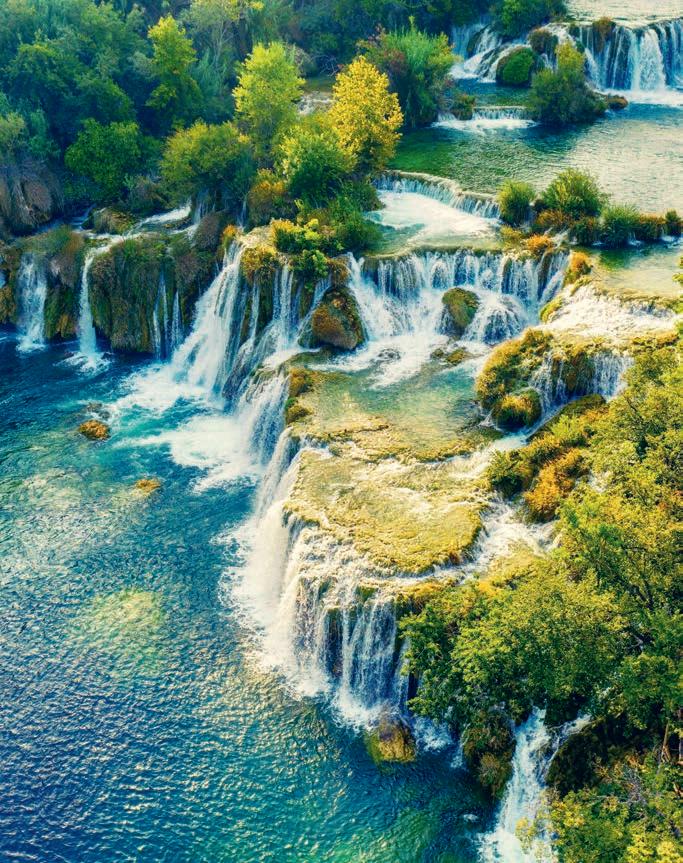
Water, water everywhere… (clockwise from above) The various cascades of Skradinski Buk in Krka National Park measure between 200m and 400m wide; the Kornati archipelago includes around 150 islands, islets and rocks; Mljet National Park encompasses two saltwater lakes and is a dream to explore on two wheels

KORNATI NATIONAL PARK
If there’s one place that epitomises Croatia’s maritime soul, it’s Kornati National Park. This archipelago of 89 islands and islets is seriously off-grid. Visitors can expect no permanent population, running water or electricity – just a string of starkly beautiful islands with olive groves, wild sheep, scenic hiking trails and rustic ports where you can moor your boat and fill up on hearty Croatian fare in simple waterfront taverns.
It’s a true sailor’s paradise, and a chance to turn off the boat’s motor and let the wind take you through a natural obstacle course, stopping now and then for an invigorating dive into impossibly clear blue waters.
If you haven’t got your own boat, you can join one of the many excursions on offer from marinas at Šibenik and Vodice or on Murter. You’ll spend a leisurely day sailing through the islands, pausing for swims and feasting on freshly grilled fish.
MLJET NATIONAL PARK
Mljet, Croatia’s greenest island, is a popular day trip for those visiting Dubrovnik. A third of the island is covered in a national park packed with pine-shaded walking and cycling trails that wind around two inland saltwater lakes, all encircled by thickly forested peaks. You’ll even find a fairy-tale island, Sveta Marija, within the larger of the two lakes, complete with a Benedictine monastery dating from the 12th century. Take a boat to wander its church and gardens.
Hike up to the top of Mount Montokuc (235m) for superb panoramic views of the
national park and beyond. Afterwards, cool off with a refreshing swim in one of the lakes. Both the ferry ports of Pomena and Polače have paths leading directly to the national park entrances and facilities to hire a bike.
KRKA NATIONAL PARK
Follow the Krka River inland from the city of Šibenik and you’ll soon reach one of Croatia’s most dramatic landscapes. Krka National Park is a wondrous world of rushing waterfalls, serene rivers and hilltop viewpoints that offer sweeping vistas.
Start in the village of Skradin, where a boat takes you along the Krka River to Skradinski Buk, the first of several eye-popping waterfalls. From here you can follow trails uphill as
the views of the waterfall become even more impressive. Stop by the little ethnographic museum for a glimpse into what rural life in Croatia used to be like.
The national park’s boats take you further upstream, including ones that stop at the islet of Visovac, where a Franciscan monastery has stood since the 14th century. Carry on upstream even further for more drama in the form of Roški Slap, one of Krka’s most thunderous waterfalls.
Added to the other gems featured here, these marine parks truly are jewels in the Adriatic. Whichever ones you decide to visit for yourself, you’re bound to be in for a mesmerising experience with memories that will likely last a lifetime.

Alamy;
Julien Duval
Secret beaches
Five lesser-known shores to uncover across Croatia
Impossibly clear waters, sheltered pebbly coves, long stretches of sand – Croatia’s Adriatic beaches are among the best in Europe. If you want to avoid the crowds and find a secluded spot to yourself, then follow M ary Novakovich’s guide to Croatia’s uncrowded coastal retreats...
1
Čikat Bay, Lošinj
Three-pronged Čikat Bay on the Kvarner Gulf island of Lošinj has a stretch of beach to suit almost everyone. Follow the tree-shaded footpath to Blatina for paddleboarding, beach bars and a family atmosphere. Carry on past two luxury hotels to find a series of little pebbly coves scented by pines, including one where dogs are welcome.
You’ll feel instantly soothed by the fragrance of wild herbs that covers most of the island, which is what drew the Austrian emperor Franz Joseph (and his mistress) here back in the 19th century. He was convinced Lošinj’s aromatic air was good for his health. It’s certainly invigorating.
2
Mlini Beach, Marinkovac, Pakleni Islands
If you want to get away from it all, take a taxi boat from Hvar Town to Marinkovac, one of the Pakleni Islands scattered just to the west. Ask the taxi to drop you off at Mlini Beach on the western side of this strangely shaped island, and feel yourself instantly relax under the pines to the sound of cicadas. Mlini’s shore is particularly rocky and pebbly, so be sure to bring some swimming shoes to make the most of it.
3 Saplunara Beach, Mljet
In a country better known for its pebble-strewn shores, Saplunara on the eastern side of Mljet island has not one but two sandy beaches right next to each other, under the pines. Rows of bamboo-shaded sunloungers line part of Velika Saplunara, the larger of the two, and both of them have rustic bars where you can refuel with grilled meats and cold drinks.
You’ll feel the hours pass in a delightful haze of relaxation as you watch sailboats
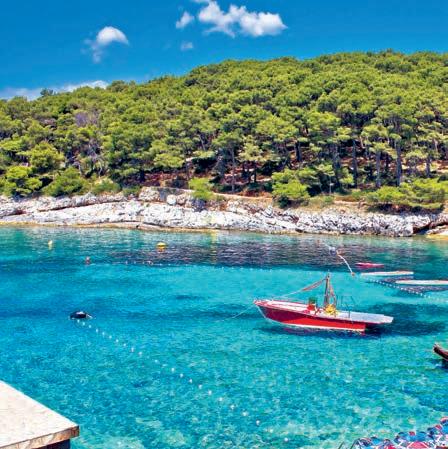

Alamy; Aleksandar Gospić; Shutterstock
True blue (clockwise from top left) Čikat Bay was a favourite of Austrian emperor Franz Joseph; Mljet island’s Saplunara is known for its sandy beaches; Cape Kamenjak offers fine snorkelling; Queen’s Beach is the longest stetch of sand in Croatia; the Pakleni Islands offer secluded coves
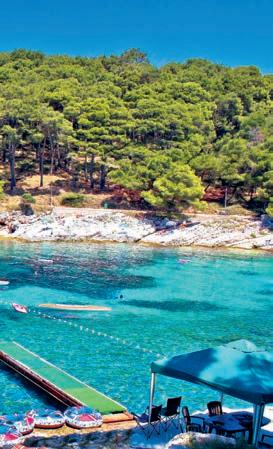
Did you know?
According to the European Environment Agency, Croatia’s Adriatic Sea is officially the cleanest in Europe. The agency tested more than 22,000 beaches in the European Union and Croatia came out on top. So there’s even more reason to enjoy a refreshing dip in Croatia’s Adriatic waters.

drift in and out of Saplunara Bay. There’s even a third beach, the very secluded Limuni, about a ten-minute walk away.
4
Cape Kamenjak, Istria
Istria’s southernmost point is a wild and rugged place of dramatic cliffs and craggy coves, whose landscapes and biodiversity have rightly been given protected status. Part of the Kamenjak Nature Park, the cape is indented with rocky bays that are fabulous for snorkelling. Watch as locals dive from the cliffs, then join them afterwards at one of the quirky beach bars among the pines.
Some coves, including Debeljak and Školjić, are simpler to reach than others. But it’s very easy to rent kayaks from some of the bigger beaches, letting you explore every nook in this uncrowded peninsula.
5
Queen’s Beach, Nin
The northern Dalmatian town of Nin is magical enough, with its old town set on a tiny island, and that’s even before you consider Queen’s Beach. The longest stretch of sand in Croatia was said to be a favourite of the wife of the medieval king Tomislav, hence its name (Kraljičina Plaža in Croatian). Its shallow waters make it popular with families, and you can rent sunloungers and canoes.
What makes this place shoot up anyone’s list of top Croatian beaches, though, is the natural mud spa just behind it. Do as the locals do and slather yourself with its reputedly healing mud for the perfect natural treat.

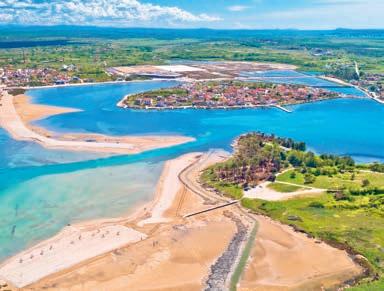
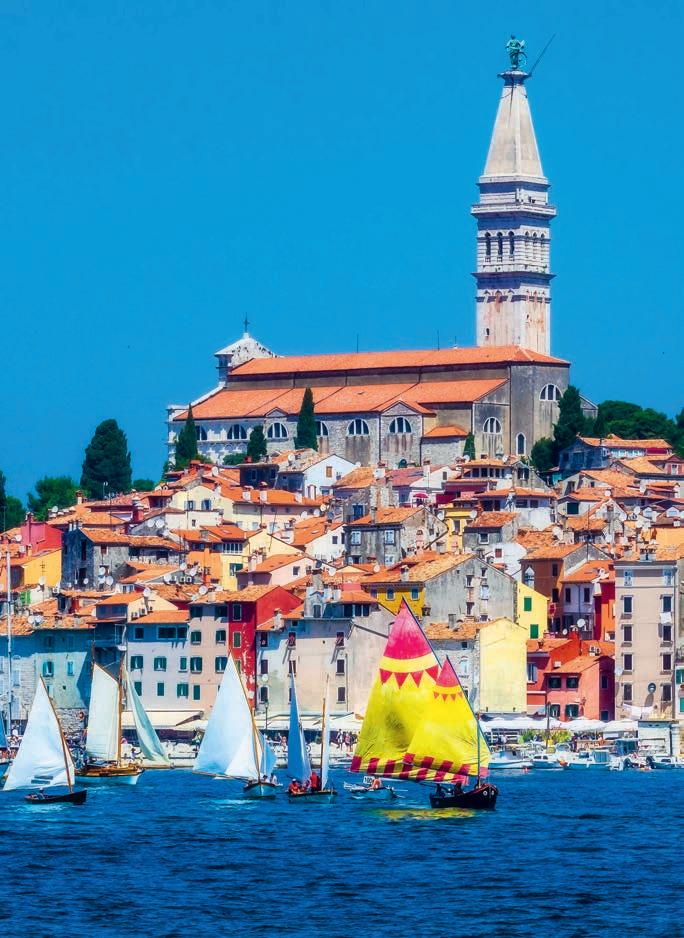
Exploring by sea (above) Classic sailing boats make a colourful sight in front of the old fishing port town of Rovinj on Istria’s west coast; (opposite page; top to bottom) Paradise Beach in Lopar on Rab island has a sheltered harbour for yachts; the large island of Krk in the Kvarner Archipelago has everything from charming towns with Roman mosaics depicting mythological stories to family-owned wineries and secluded pebble and sand beaches for swimming
Trip planner:
Set sail in Croatia
Travel writer and
sailing
expert Tristan Rutherford guides us through Croatia’s best sailing adventures
Croatia is blessed with more than 1,200 islands and one of the longest coastlines in Europe. A dozen maritime empires — Romans, Venetians, Austrians — left a waterside legacy of amphitheatres, palaces and forts. Welcome to a nation made to be explored by sea. Best of all, sailors in autumn will find tranquil waters, with sea temperatures as warm as May and June.
1THE KVARNER ARCHIPELAGO
Key islands: Krk, Lošinj, Rab Why? To explore the remote beauty of over 100 islands in the calm and crystal-clear waters of the Kvarner Gulf. How? From Rijeka airport, situated on Krk, take a bus or taxi to Rijeka’s newly renovated port zone. Find boat rental agencies along the coast. Public ferries run from Rijeka to islands including Lošinj and Rab.
Rijeka is a fine place to start in the Kvarner Archipelago. Locals call the port ‘the city that flows’, thanks to its rich maritime history.This legacy is best eaten in Rijeka’s seafood diet of preserved octopus and Kvarnerski škamp (langoustines), and best seen in historic houses like the Sugar Palace, a former sugar warehouse in a neo-Baroque building, which showcases shipbuilding history and other salty tales. From 2026, Rijeka’s new (and green energy-powered) marina will become the largest launchpad for the Kvarner Islands.
The Kvarner Gulf is a sailor’s dream. Calm seas are protected by the Istrian peninsula to the west and one of Croatia’s biggest islands, Krk, to the east. Krk features Roman mosaics (in Krk town), vineyards growing the indigenous žlahtina grape (at Ivan Katunar winery) and boat-only beaches like Golden Bay (named after the impregnable golden cliffs that keep most shore visitors away).

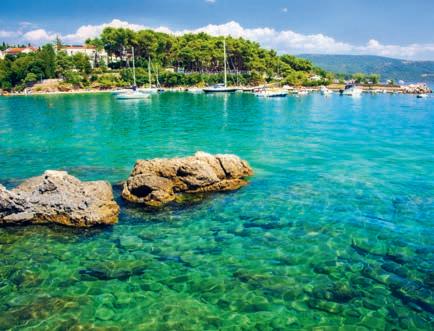
The Kvarner Archipelago consists of more than 140 islands, islets and reefs. Try Lošinj for biodiverse hiking trails, or Pag for UNESCO-protected cheese and olive oil. Or Male Srakane for absolute serenity (the island has a census population of two).
Wherever they explore, sailors will see the Kvarner Gulf’s pod of 100 dolphins. One of the Kvarner Archipelago’s most historic islands has a royal connection. Rab is where King Edward VII sailed with his lover Wallis Simpson in 1936. This jewel of an island is crowned by 30 sandy beaches. On naturist
beach Sahara (named after its golden sand), the Simpson introduced the king to skinny-dipping.
Over on the huge island of Cres, there’s more sheep than people. Anchor off Lubenice Plaža, a white shingle swoosh voted one of the best beaches in Croatia. As it’s a 90-minute hike uphill to the road above, boaters generally have the beach to themselves. At Cres’s principal port, epicureans can sample mastic ice cream flavoured from pine resin, honey direct from beehives and jam made from wild cherries.
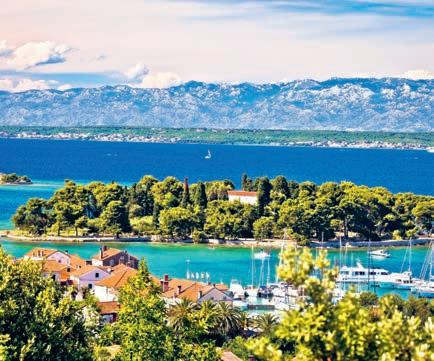
2
THE ZADAR ARCHIPELAGO
Key islands: Dugi Otok, Ugljan, Pašman
Why? To sail from a buzzing port city to a dozen wild islands.
How? Zadar Airport has direct flights from all over Europe. It’s a 20-minute bus ride, costing €5, from the airport to Zadar’s historic port, from where ferries depart for nearby islands like Dugi Otok and Ugljan. Marinas dot the mainland coast to the south.
Zadar has been an elegant gateway to the Adriatic islands for more than 2,000 years. The people of Zadar are born seafarers who helped to build the Roman armada. The city walls are inscribed by UNESCO. Today the port parties like Palma or Palermo — sparkling wine is drunk in al fresco bars alongside medieval churches.
The finest toast to modernity is the Sea Organ art installation on Zadar’s waterfront. This aquatic music player bellows and hums as waves pass through, emitting a watery serenade.
Some Croatian islands, like Hvar, are rightly famous and have a tourist infrastructure to match. By comparison, the islands near Zadar are positively feral.
Ugljan, the closest island out, is zigzagged by hike and bike trails. The ‘green island’, as it’s known, is carpeted with fig orchards and olive groves, allowing boaters to stock up on jam and olive oil in charming ports like Ugljan town. The bay of Muline, with its jetty and mooring buoys, is especially welcoming to boaters.
3
THE ŠIBENIK ARCHIPELAGO
Key islands: Kornati, Zlarin, Prvić Why? Lesser known islands, UNESCO-listed heritage and some of the world’s freshest seafood.
How? Fly into Zadar or Split and take a bus or taxi to Šibenik, passing big marina towns like Primošten and Biograd na Moru en route. Private boat trips operate from Šibenik to the Kornati Islands but a private boat offers greater flexibility.
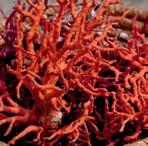
Dugi Otok is another fragrant wild child. It’s the Adriatic’s seventh-largest island but has less than 2,000 inhabitants, most of whom tend seaside vineyards or fish for bonito and squid. The laid-back island’s star attraction is Telašćica Nature Park. Snorkel to discover 58 sponge species and bushy coral. Every Dugi Otok anchorage or mooring buoy is scented by a forest breeze from Aleppo pines and holm oak. For an even slower pace, sail on to lonely islands like Ist, which has no ATM and no worries. Or the tiny islet of Olib, where all motorised transport is banned.

A stunning starting point is Šibenik, Croatia’s oldest Adriatic city. Above Šibenik’s historic quarter, St Michael’s Fortress offers views over the coastal island that you’ll sail through. Before casting off, say a prayer at the Venetian-era St James Cathedral, a UNESCO World Heritage Site of spellbinding complexity. One could spend a week in Šibenik sampling local delicacies like squid ink risotto or local lamb slow cooked under an iron dome.
Yet a maritime miracle awaits. The first island out is Zlarin. It’s ringed with red coral and famed for boating regattas, which means that sailors will receive a warm welcome. Moor stern-to under swaying palm trees on Zlarin’s historic promenade, then try the island’s home-made brandy and limoncello. En route from Šibenik to Zlarin, sailors will pass the UNESCO-listed Fortress of St Nicholas, an immense triangular castle that makes a popular Instagram shot. Like most nearby sights, it’s only accessible by boat.
A dozen islands within easy reach of Šibenik could steal a sailor’s heart. Like Baljenac, an island criss-crossed by dry stone walls, making it look like a giant’s thumbprint. Or Žirje, an isolated speck, where yachts are welcomed with mooring buoys and safe anchorages on sandy-bottomed seas.
The greatest prize is the Kornati Archipelago. These 100 sun-drenched islands are perhaps Croatia’s greatest gifts to yachties.
The archipelago sits within the country’s largest maritime reserve, which means no cars, no people and no trace of modernity: just 69 species of butterfly and a few curious lizards. Nine certified diving sites welcome snorkellers and scuba divers to see fleeting tunas, loggerhead turtles and a second resident pod of 150 dolphins.
Island heritage (this page; top to bottom) The waterfront in the town of Preko on Ugljan Island in the Zadar Archipelago, with a view of the little island of Galovac; Telašćica Nature Park is known for its corals; the island of Murter is part of the Šibenik Archipelago; (opposite page; top to bottom); the Pula Arena, a Roman amphitheatre on the Istrian Peninsula; Peristil Square in Diocletian’s Palace in the Dalmatian city of Split dates back to the year 3AD
4
THE SPLIT AND DUBROVNIK ARCHIPELAGO
Key islands: Mljet, Lastovo, Brač Why? Sailors are spoilt for choice, as two dramatic ports grant access to sandy islands and marine reserves.
How? Fly into the well-served airports of Split or Dubrovnik. Boat rental options are plentiful, as are ferries and fast catamarans to the plethora of nearby islands.
What a choice. Start from Split, with its Roman-era marble-paved centre, or Dubrovnik, a UNESCO-listed city, with its vast fortifications seen on Game of Thrones Split and Dubrovnik are divided by some of the world’s most storied islands: hip hangout Hvar, Marco Polo’s birth island of Korčula and telegenic Vis, the movie location for Mamma Mia! Here We Go
Again. Despite their popularity, each island welcomes boaters with isolated beaches and boat-only coves. Within easy sailing distance from Split is Brač with its snowwhite peninsula at Zlatni Rat beach, 100 miles of coastline to explore, and waterside eateries serving buzara, a seafood stew.
For offbeat charm nearer Dubrovnik, moor off Mljet. A full third of the island is a National Park alive with mouflon, fallow deer and 119 bird species, plus two lakes.
For serious seclusion, sail to Lastovo, the most remote of Croatia’s populated islands. Following the Second World War, Lastovo was sealed off as a submarine base, unwittingly preserving its all-organic cuisine and colonies of lobster. Walk inland to be the sole hiker on around 130 miles of trails.

5THE ISTRIAN COAST
Key islands: The islands of the Brijuni Archipelago Why? The region serves up newly opened islands, Roman ruins and hidden coves on Croatia’s Italianate coastline, offering a wonderful blend of scenery and culture. How? From Pula Airport, take the €6 airport bus into town, or simply grab a quick taxi ride to any of the Istrian peninsula’s marina hubs. Ferries depart Pula’s main port for the islands. Boats for the Brijuni islands typically leave from the historic port of Fažana.

Istria is a heart-shaped peninsula that dangles like a teardrop into the Adriatic Sea, with a long, indented shoreline. It is gastronomically famous for ingredients including truffles (which you can forage for with local guides), oysters, wild asparagus, bone dry malvasia white wine and incredible, fresh seafood. Its principal port, Pula, is dominated by a well-preserved Roman amphitheatre that dates back to the 1st century AD. It is the only remaining Roman theatre that still has all four side towers preserved. Among Croatia’s greatest sailing experiences is Brijuni National Park, on Istria’s west coast. The archipelago of 14 islands was off-limits for decades as a presidential retreat, which means that nature thrived in isolation in the form of sea sponges, birds of prey and 600 indigenous plants. Today, it is open to visitors and after mooring up, sailors can explore the island of Veliki Brijun by hired bike or electric buggy. The archipelago’s sunny microclimate allows swimmers to cool off with a dip in countless coves. There’s a chance to discover sunken history too, and snorkellers at the Verige Archaelogical Site will see the fascinating remains of an authentic Roman villa.
In 2024, the island of Mali Brijun fully opened to tourism for the first time in 100 years. This former Austro-Hungarian naval outpost with its 175m-long military fortifications, has reverted to nature. Hike into the feral interior to find horseshoe bats, whistling goldfinches and fallow deer.

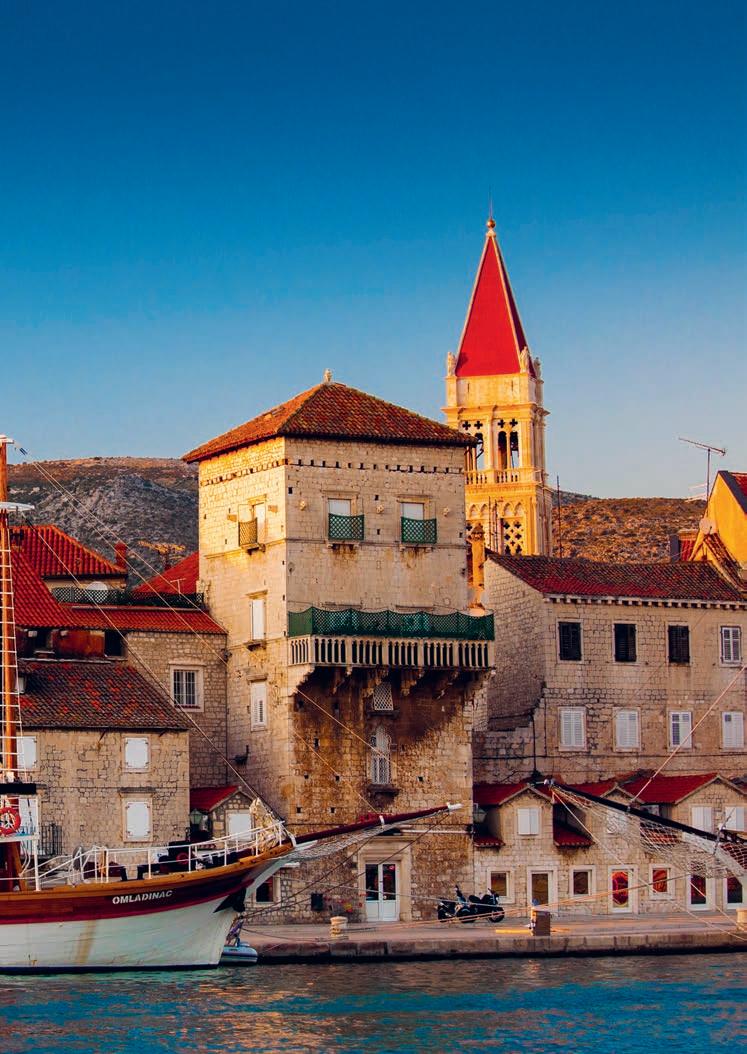
Culture
From the medieval towns and citadels of the Dalmatian coast to the artisans of Croatia’s lesser-visited far north, there is a wealth of unique cultural experiences and sites to explore in every corner of the country
Come rain or sun…
Croatia’s culture always shines

Croatia’s rich history of art and creativity is not fully appreciated, and its cultural institutions offer some incredible days out, whatever the weather. Ellie Swain looks at how you can ensure every day you spend here is a work of art
Come rain
Go back to prehistoric times
The Krapina Neanderthal Museum in northern Croatia welcomes visitors to a site where the largest collection of Neanderthal fossil bones in Europe was uncovered in 1899.Visitors can glimpse exhibits that shine a light on early life on this planet. And if that intrigues you, then you should also pay a visit to the Vučedol Culture Museum, near Vukovar, an indoor archaeological site showcasing the remnants of a 5,000-year-old settlement.
Visit Croatia’s cultured capital Zagreb has plenty to do when it’s raining, thanks to a variety of innovative museums. For example, the touching and truly inventive Museum of Broken Relationships turns heartbreak into art (try not to cry when reading its personal stories), while the Croatian Museum of Naïve Art became the first museum in the world to be devoted to this titular art form when it was founded in 1952.Then there’s the City Museum, housed within a 17th-century convent, which shares the capital’s past through interactive exhibits. For something quirkier, head to the Museum of Laughter (or HaHaHouse), which is filled with playful installations, or pay a visit to Zagreb’s Mushroom Museum, home to more than 1,500 freeze-dried fungi.
Lose yourself in art
Croatia is not short of great galleries. In Rijeka, the Museum of Modern and Contemporary Art hosts bold art exhibitions and works from local and international artists. And over in Split, the Meštrović Gallery honours one of Croatia’s most acclaimed sculptors, Ivan Meštrović, presenting some of his more eye-catching 20th-century creations, fashioned from marble, bronze and wood.




Rainy days (this page; clockwise from top) The Musuem of Broken Relationships blends art with personal heartache stories; shining a light on early life at the Krapina Neanderthal Museum; the Croatian Museum of Naïve Art in Zagreb was the first museum in the world to be devoted to this particular kind of art form; inside the Meštrovic Gallery; explore prehistoric sites at the Vučedol Culture Museum Alamy; Sanjin Kaštelan, ZTB; Denis Peros; Filip Beusan; Ivan Šardi
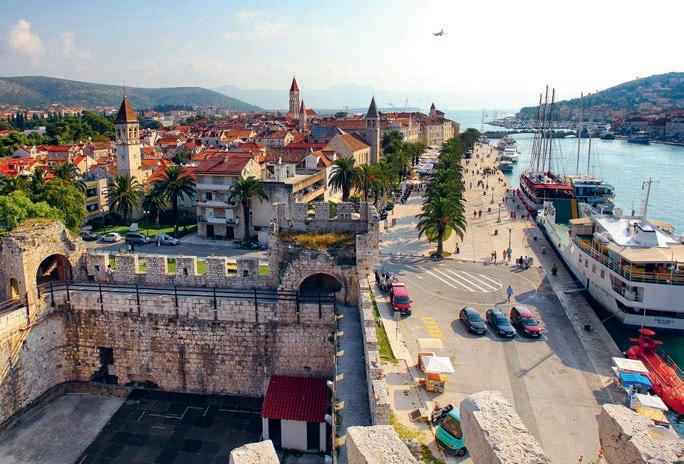
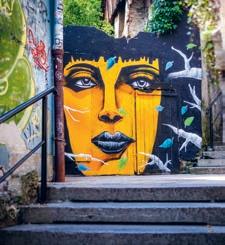
Come sun
Admire Croatia’s street art
Vukovar, a city once scarred by war, shares its story through its striking murals. These have breathed new life into the town, intertwining historical reflections with modern creativity.
Over in Istria, the stone walls of the medieval town of Vodnjan have also been given fresh life by international and local artists, who have introduced modern expression to these ancient alleyways. The hues of its murals really pop under the Adriatic
sunlight, making a simple stroll feel like you’ve stepped into a living art exhibition.
Go back in time at Trogir
The UNESCO-listed town of Trogir is best explored on foot under sunny skies. Meander the cobblestone streets past Romanesque churches, Renaissance palaces and age-old stone houses. Take a break from the heat at one of the cosy cafés spilling out onto the square to see local people going about their day. Or sit outside Trogir Cathedral and watch the sunset, its golden hues streaming down on the town’s pale limestone buildings.
See the fortifications of Šibenik Šibenik’s four fortresses are fine places to combine sea views with stories of the town’s history. St John’s Fortress is the largest and highest of the quartet, and on warm days you can sit beneath its pincers with a coffee and enjoy the city views. But these ancient sites are best enjoyed on summer evenings when the open stage at St Michael’s Fortress hosts local shows, or when Barone Fortress puts on jazz concerts and open-air movie nights.

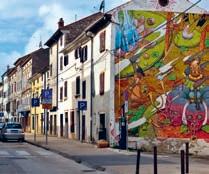
Let the sun shine (this page; clockwise from top) Trogir was designated a UNESCO World Heritage site in 1997; explore Trogir’s ancient streets by bicycle, bouncing gleefully over the uneven cobbles; visit Vodnjan for its vibrant murals, which have been painted by local and international artists; learn the stories behind the street art in Vukovar, which dots almost every corner of this city
Meet the locals: The north
Rudolf Abraham heads to the far north of Croatia to ask the people who know it best, its locals, what makes this region so unique to visit
Picture a green, fertile region in the northernmost reaches of Croatia. Spread between the broad blue arteries of the Mura and the Drava rivers, the landscape ranges from rolling green hills carpeted with vineyards to extraordinary habitats of riparian forest that range alongside riverbanks that form part of the Mura-Drava-Danube UNESCO Biosphere Reserve. This is Međimurje.
The region is rich in traditional culture and heritage – its popevka folksongs, for example, are included on UNESCO’s list of Intangible Cultural Heritage. Add a genuinely warm welcome, accompanied by delicious local cuisine, and you have some understanding of what makes it so special. Croatia’s northernmost county embraced a greener form of tourism long ago, and both slow travel and the preservation of traditional local heritage are synonymous with any visit.
Zvonko Lajtman
Local host and biodynamics expert
“The exceptional value of the soil, the slopes and the orientation of our vineyards and orchards yield fruits year after year, from which we offer our guests premium wines and fruit juices.”

“The entire estate and the rural holiday home itself are infused with, and guided by, biodynamic principles of cultivation, design and sustainability. Biodynamics on our estate is both a way of thinking and living.”

“Arriving at our adrenaline park is a meeting with the primal spirit of the forest. It’s a test of one’s abilities and limits. You can also enjoy a gourmet touch by trying dishes that are the original symbols of Međimurje.”

It takes a village (this page; left to right) ) Tatjana, Zvonko and Jelena are all proud to call Međimurje their home; (opposite page) Wooden toys and intricately painted gingerbread decorations called licitari are just a handful of the huge wealth of traditional crafts that have been preserved here 28 The Wanderlust Guide to Surprising Croatia
Jelena Horvat Adventure Park Animator
Tatjana Hažić Winemaker
3 ways to explore and help preserve
Međimurje’s local heritage
1
Listen to folk songs
Međimurska popevka is a traditional form of folksong that has been passed down from one generation to another, and it is deeply rooted in local culture and identity. Tinged with melancholy and rich in melody, these songs are performed solo or as part of an ensemble, either at home or in a range of social settings. They are part of the collective experience of growing up and living in this region of Croatia. You can hear popevka performed at the annual Međimurska Popevka Festival in Nedelišće, just outside Čakovec.
2
Support local artisans
The presence of so many traditional crafts in Međimurje means there are plenty of evocative souvenirs – the purchase of which helps to support local artisans. Among these are licitari – ‘gingerbread’ decorations – along with traditional local pottery, bobbin lace, wooden toys, painted Easter eggs with colourful designs on a black background, medenjaci (the edible, undecorated counterpart to licitari), handmade Christmas decorations and Nativity scenes.
3
Visit the museums
Visit the Treasury of Međimurje, a museum showcasing the region’s rich history, traditional culture and heritage. This is housed in the Zrinski Castle in Čakovec, a fortified Renaissance palace, rebuilt in Baroque style in the 18th century, which has been beautifully restored. Elsewhere, the Med Dvemi Vodami Visitor Center in the village of Križovec introduces the landscapes, nature and habitats of the Mura and Drava rivers.




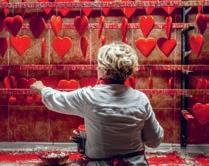

Getting crafty with Zagorje’s artisans
The region of Hrvatsko Zagorje neighbours Međimurje and is home to several heritage crafts, including makers of traditional gingerbread and wooden toys. Both these skills are inscribed on the UNESCO list of Intangible Cultural Heritage and are linked to the town of Marija Bistrica, a major place of pilgrimage. These items were often bought by pilgrims as small souvenirs for their families back home.
“I was ten years old when my father started teaching me,” said Stjepan Mikuš, a wooden toymaker in the village of Laz Stubički, near Marija Bistrica. “From that moment on, I never wanted to do anything else.”
In his workshop, the air was thick with the smell of sawdust. He was filing down the rough edges of what gradually turned into a small wooden horse. Mikuš has been making these toys for around 50 years.
“It’s an authentic local tradition, and it’s something I want to see continue and help to preserve,” Mikuš explained to me.
Later, the horse will be painted in bright colours, then it will have wheels attached so that it can be pulled along. It’s not unusual for these stages to involve the whole family working alongside each other. Danijel Hajnić, a maker of wooden toys in the village of Tugonica, works with his parents and his wife Marijana. And Brankica Šćuric, a gingerbread maker in Marija Bistrica, told me that her children have always helped her out at work, allowing them to learn the process of gingerbread craftsmanship from an early age.
This sense of heritage and the value these crafts hold as a part of local identity show how important it is to keep them alive. It is a sentiment that is deeply rooted in Zagorje.
Gordana Mahmet Habazin, a third-generation traditional gingerbread maker in Marija Bistrica, told me: “I began making gingerbread because I wanted to continue the family tradition. For me, it’s a way of life – it’s an important part of who I am.”
Off-season Dubrovnik

This mesmerising Medieval city with its imposing forts, Renaissance architecture and storied past is unsurprisingly popular with visitors in summer. But go off-season and you will be rewarded with authentic, immersive cultural experiences untouched by the crowds, as Dubrovnik’s locals reveal


TUNE INTO THE DUBROVNIK SYMPHONY ORCHESTRA
“The Dubrovnik Symphony Orchestra (DSO), which is celebrating its 100th anniversary this year, offers a high-quality programme to visitors to Dubrovnik in both the spring and winter months. March is dedicated to young musical talents, while throughout the months of April, May and June, the DSO holds concerts in beautiful churches and the unique venue of the Rector’s Palace, where it hosts world-renowned musicians.
“The DSO also organises Dubrovnik Musical Autumn, International Conducting Masterclass Lovro Matačić, and probably the highlight of wintertime in Dubrovnik is the New Year Concert on January 1st.” Slobodan Begić, manager of Dubrovnik Symphony Orchestra


FOLLOW THE LOCALS
“The best tip for off-season travel in Dubrovnik: Slow down and follow the locals. With the summer rush gone, life in Dubrovnik finds a gentler rhythm. Mornings begin with coffee at a sunny café terrace, not a crowded tour. Locals chat in the streets, markets bustle with everyday activity and the city opens itself up to genuine connections.
“Without the summer heat or rigid tour schedules, you can truly immerse yourself in the city’s timeless charm. Stroll the limestone-paved streets at your own pace. Walk into hidden churches. Visit museums without the queues. Even the most popular spots – like the city walls – can be enjoyed in solitude, giving you the space to take it all in.”
Tomi Coric, tour guide
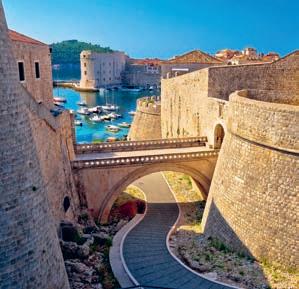
Blaise gobours the city’s patron saint; Dubrovnik Symphony Orchestra fills the atrium of the Rector’s Palace with music; the bridges and gates leading to the Old Town are quiet in the off-season, when locals enjoy cups of coffee on
Timeless charm (this page; top to bottom) Walk the city walls during the off-season, and you will have them to yourself to admire views over the Old Town’s red rooftops; The Feast of St
terrace cafés


EXPERIENCE THE LINĐO FOLKLORE ENSEMBLE
“The Linđo Folklore Ensemble specialises in traditional music and dance from various regions of Croatia, and we guarantee a lively and entertaining experience that will transport you to the heart of Croatian culture. We feature traditional songs and dances that have been passed down through generations. Our ensemble is made up of talented singers, musicians, and dancers who are dedicated to preserving and promoting Croatian culture and heritage.
“During the off-season period (November until April), we perform 20 to 30-minute programs in front of the Church of Saint Blaise every Saturday from 11:30am to 12pm. In December, our program is part of the Dubrovnik Winter Festival. We have a concert on December 13th at the Dubrovnik Theatre. At this concert, we perform various dances and songs from different regions of Croatia.
“Also, in December, we have a vocal-instrumental concert at the Franciscan Church, where we perform selected songs from the collection of rich Croatian Christmas songs. On December 24th and 31st in the morning, we perform the traditional Kolenda, where, along with traditional Christmas carols, we wish everyone all the best for the upcoming holidays.”
General manager of Linđo Folklore ensemble, Vlaho Kljuna

ENJOY QUIET LUXURY
“Travelling to Dubrovnik during the off-season is a great way to experience the city without the overwhelming summer crowds. You’ll have the city’s alleys, historic landmarks and sea-facing walls almost to yourself – a quiet luxury that’s hard to find in peak season. Many tourist-oriented restaurants may still be closed, but that only means you’ll eat where the locals do and that’s the best way to experience local cuisine. From late March onward, the weather is often beautiful. I recommend taking a short boat ride to Lokrum to enjoy the peacocks and botanical gardens, which feel like a private retreat. It can get crowded in the summer, but visiting off-season offers a peaceful and meditative experience.
“If you’re planning to visit even earlier in February, you might want to attend the Feast of St Blaise on February 3rd. This deeply local celebration honours the city’s patron saint with parades, music, traditional dress and centuries-old customs. It’s a unique cultural experience that few tourists get to witness.”
Mislav Fileš, tour guide


Cultural experiences (this page; top to bottom) Get to the heart of traditional Croatian culture with the Linđo Folklore Ensemble, which holds performances of songs and dances during winter to showcase and preserve Croatian heritage; the botanical gardens of Lokrum Island, a short boat trip from the Old Town, are a peaceful haven in winter without the crowds; colourful peacocks roam the uninhabited island of Lokrum in peace during the winter months


UNESCO sites minus the crowds
Four secret yet spectacular World Heritage sites
While the UNESCO-listed sites of Dubrovnik’s Old Town and Split’s Diocletian’s Palace are undeniably worth seeing, they are firmly on the tourist trail, meaning it can be tough to escape the crowds. However, Croatia is home to many UNESCO World Heritage sites that are just as splendid but blissfully untroubled by the masses. Rachel Truman picks four to visit…
1
ST JAMES CATHEDRAL IN ŠIBENIK
Facing out across the deep-blue Adriatic, Šibenik’s gleaming cathedral is a show-stealer set in the handsome harbour city’s historic quarter. This grand Gothic and Renaissance masterpiece was a long time in the making, and its construction by three successive architects took more than a century.
Built entirely from stone quarried on the islands of Brač, Rab and Korčula, it was consecrated in 1555. Among its notable architectural and artistic features are its large cupola and decorative frieze, which features 71 intricately carved faces.
The fact that the cathedral has been preserved wholly in its original state is another reason why it is one of the country’s most treasured buildings.
2
THE HISTORICAL CORE OF TROGIR
History is written into the time-worn laneways of Old Trogir, an almost perfectly preserved medieval port clustered on an islet along the Dalmatian coast. Its story stretches back far further than that, however: Tragurion was founded in the third century BC by the Greeks. Cross over the bridge and weave around the lanes of the dinky historical core to imagine life in the 12th century, when many of its buildings were constructed.
The Romanesque Cathedral of Sveti Lovre and its imposing belltower are magnificent, as are its palaces and squares. But the town’s simple stone churches and medieval houses are just as intriguing. What remains of the once-mighty city walls can be seen in the

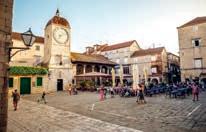

south-west corner of the isle along with the 15th-century Kamerlengo fortress.
3
EUPHRASIUS BASILICA
Bishop Euphrasius put Poreč, then Parentium, on the map when he built his grand basilica in the sixth century AD in this settlement on Istria’s west coast. This episcopal complex, which Euphrasius built on the site of an older basilica, is often heralded as one of Europe’s most impeccably preserved early Christian structures. Step inside to gaze in awe at the gleaming gold Byzantine mosaics that adorn the central apse. These intricate scenes are up there with the famous mosaics of Ravenna, Italy. You can climb the bell tower (added in the 16th century) to get a sense of the scale of the entire complex and the labyrinthine streets of Poreč’s old town.
4
STEĆCI
Not all of Croatia’s UNESCO sites are awe-inspiring buildings or artistic splendours. Some intrigue more than they wow with their grandeur. The stećci are a prime example of a more obscure treasure. These mysterious medieval gravestones, which are also found in Bosnia and Herzegovina, Serbia and Montenegro, are made from large rectangular limestone slabs and are particularly noted for the decorative motifs and figures carved into them. This tradition began in the 12th century and gathered pace over the next 300 years before the custom stopped entirely. You’ll find Croatia’s most impressive stećci collections in two necropolises – Velika and Mala Crljivica in the village of Cista Velika and Dubravka/St Barbara in Konavle – which have 4,400 between them.
Heritage to savour (clockwise from top left) St James Cathedral in Šibenik is built entirely from stone quarried on the islands of Brač, Rab and Korčula; Trogir’s architecture is just one of the tell-tale signs that Venice had a hand in shaping its history, although the Greeks got there long before them; don’t forget to look up when exploring the Euphrasius Basilica; Croatia’s medieval gravestones, or stećci, might not be as flashy as other UNESCO-listed sites but they are fascinating Igor Zirojevic; Julien Duval
Cultural calendar
Croatia comes alive with cultural events all year round. Here’s just a taster of what to expect, whatever month you visit
January
Museum Night, nationwide
Enjoy free entry to hundreds of museums and galleries across the country for one night only – usually hosted on the last Friday of the month.
April
February
Rijeka Carnival
Throw yourself into the festivities, as traditional Croatian music and colourful costumes rise to the fore at events such as the International and Children’s Carnival Parades.

May

Istra Music Festival, Poreč This music festival is held every spring and welcomes the arrival of international choirs and orchestras, bringing together top ensembles for several days of classical concerts across Poreč’s historic venues.

Delmates vs Romans Match, Sinj
re-enactment match inspired by an ancient form of football. Cheer on teams battling in authentic costumes.
October
Truffle Festival, Istria
Join truffle hunts, savour tastings and get stuck in with hands-on culinary workshops during Truffle Day events every weekend throughout October.

Spring Procession of Ljelje/ Kraljice, Gorjani
In Gorjani village in May, girls dress as queens and lead the spring procession. Teamed with music, this ancient tradition celebrates Slavonian heritage and local folklore.
August
Lađa Boat Marathon, Neretva River
Observe a nail-biting river race alongside tens of thousands of other spectators, as around 400 rowers compete against the clock over 22.5km.
November

March
Festival of Lights, Zagreb
Welcome the arrival of spring as Croatia’s capital is transformed into a glowing spectacle of sparkling light installations and fascinating art.
June
Half New Years Eve Celebration, Korčula
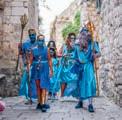
This unique and unforgettable summer tradition is embraced by locals and visitors alike, and sees the streets of the town transform into a contagious carnival of costumes, music and dance.
September
Vinkovci Autumn
Discover more about the region’s long-standing heritage, from tamburitza melodies to captivating folk dances, and immerse yourself in Slavonian culture via traditional costumes, music and customs.

Saint Martin’s Day (Martinje), nationwide

The Feast Day of St Martin (11 Nov) celebrates the patron saint of winemakers and the year’s new vintages. In Sveti Martin na Muri and Požega, join locals for tastings and festivities marking the harvest.


December
Dubrovnik Winter Festival
During the festive season, Dubrovnik’s charming Old Town fills with seasonal cheer, including Santa parades, a Christmas flea market and live music.


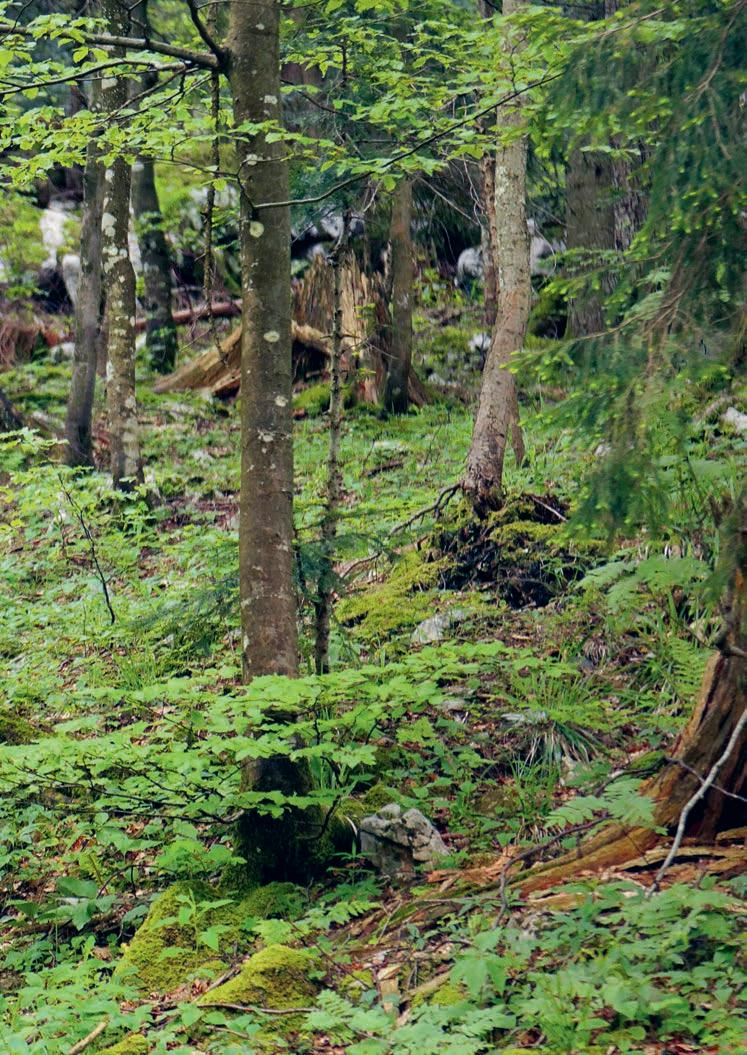
Nature
Croatia is a lot wilder than you think – just ask the brown bears that roam its rugged Gorski Kotar region. We show you how to explore the country’s untamed corners, whether on foot or two wheels
Alamy
The bear necessities:
A frolic in the forests of Gorski Kotar
Known
as Croatia’s ‘green heart’,
this little-known region is a great bet for spotting Europe’s biggest predator, as Richard Mellor discovers
Once upon a time, Gorski Kotar’s rugged landscapes were so inaccessible and untamed that old maps called it the ‘Devil’s Garden’. And although the local infrastructure is now much improved, more than 80% of this fairy-tale pocket of south-western Croatia – less than 15km from the Adriatic coast – remains covered in dense, ancient forest.
Much of the area is protected, including the Risnjak National Park and its namesake snow-capped massif, as well as a glut of gorges, caves, waterfalls, rivers and lakes. As such, it’s the perfect environment for three of Europe’s premier carnivores – lynx, wolf
and brown bear – to thrive. Best of all: if you want to see them up close, wildlife hides lie deep in the forest and offer a hidden location from which to safely keep watch.
IF YOU GO DOWN TO THE WOODS TODAY…
It wasn’t always like this. Recent centuries saw the continent’s predator populations nosedive as they were hunted as vermin –to safeguard farmland – or simply poached. Happily, lynx, wolf and brown bear populations have rebounded in recent decades, with Gorski Kotar one of the exemplars. Measures to improve harmonious human-carnivore cohabitation have enabled


this upturn, together with the preservation of swathes of natural areas, protection orders and hunting regulations. Visitors can learn more at the Large Carnivores Visitor Center in Stara Sušica, beside a witch-hatted castle. Brown bears are especially resurgent, with around 400 now reckoned to dwell in Gorski Kotar. But despite their razorsharp claws and imposing size (bulking up to 350kg), they tend to hide away when their incredible sense of smell detects humans.
Thankfully, Gorski Kotar’s wildlife tourism makes seeing bears in the wild far easier than it used to be. One option is to stay a few hours, or even overnight, at a remote, well-positioned hide. The expert local operator CroMedo (cromedo.com) arranges photographic trips to hide locations near the Slovenian border; there are also two overnight cabin options inside Risnjak National Park (np-risnjak.hr).
Going in autumn, when the bears descend to lower areas in search of food and to bulk up for hibernation, is a prime time for sightings. There really is nothing like the thrill of seeing one of these gigantic creatures up close and thriving in the wild.
Bear truths (clockwise from top middle) 80% of Gorski Kotar is covered in forest; a bear sculpture in Golubinjak Forest Park; Stara Sušica Castle sits 800m above sea level; a western capercaillie; a grey wolf in Gorski Kotar; an elusive lynx; the region’s population of brown bears is on the up





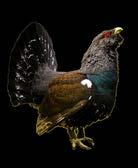
Three other wild encounters in Gorski Kotar
1 Look out for Lynx
The Risnjak massif is named after this wild cat (‘ris’ means lynx in Croatian). Local wisdom dictates that spotting one in the wild brings great fortune, but doing so is far from easy. Lynx are famously elusive and chiefly nocturnal, so it can be a long wait in a hide if you want to see one in the flesh.
2 Howling wolves
Grey wolves are likewise tricky to spot, but they do afford other forms of encounter. For example, you can join guides following their tracks in the snow during winter or hear youngsters learning to howl in the summer months. There are six packs around Gorski Kotar, living in groups ranging from two to six.
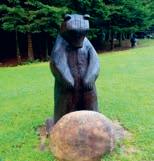
Al-fresco fun
Wildlife is far from Gorski Kotar’s sole fresh-air pursuit. Art lovers, for instance, are directed to the idyllic yet bumpy Golubinjak Forest Park where, along with a bevvy of caves, you’ll also find a lynx-themed walking trail, a 200-year-old fir tree known as the ‘Queen of the Forest’ and dozens of oak sculptures made by members of a longestablished art colony in the nearby village of Lokve.
Scattered around the area are also some handsome castles surviving from the era of the Frankopan and Zrinski noble families, who once controlled these lands. As well as the restored fort at Stara Sušica, stand-outs include the 16th-century Severin na Kupi, a manor-house-style castle bookended by cylindrical turrets, and a traditional mansion in Čabar, whose information centre tells the story of the two families.
3 A bevy of birds
More than 100 bird species – including eagle owls and redstarts – have been recorded in and around Risnjak National Park. Among the more exciting finds is the western capercaillie, a colourful, largely grounddwelling forest grouse. The Tetrijeb breeding centre in Prezid is a good place to see this species up close.
Also worth seeking out is the lemon-coloured Gomirje Monastery, a Frankopan castle later converted into Europe’s westernmost Serb Orthodox monastery. Like everywhere else in Gorski Kotar, it catches the eye.


Hiking highs
Rudolf Abraham guides us through some of Croatia’s finest cliff, coast and mountain walks
UP THE MOUNTAINS
Croatia’s coastline is backed for almost its entire length by a rugged chain of mountains where limestone scenery, sinuous ridges and craggy summits merge with dense forests pockmarked with karst dells. These mountains, criss-crossed by hiking trails and home to brown bears and golden eagles, offer Croatian hiking at its very best.
There are literally hundreds of day hikes amid Croatia’s rocky landscape, ranging from a short walk through the gorge of Velika Paklenica to the steep ascent up to Vošac on Biokovo, which takes you from sea level to over 1,400m. Other hikes include the surreal limestone formations of Samarske Stijene or the climb up Učka for a view taking in the entire Istrian peninsula. And then there’s Dinara, a sprawling mountain that peaks at 1,831m and encompasses vast areas of lush mountain pasture. It’s the roof of Croatia. However, it’s Velebit, Croatia’s most extensive mountain range, that boasts some truly astonishing walks. Home to two national parks, the heights of this UNESCO Biosphere Reserve are traversed by the 100km Velebit Hiking Trail. And for something even more epic, lace up your boots for the Via Dinarica, whose White Trail (1,260km) takes in some of Croatia’s most scenic parts on its route between Slovenia and Albania.

Steep ascents (left to right) Biokovo dominates the backdrop of Makarska; Paklenica National Park is home to nearly 180km of hiking trails
Alamy




Golden shore (this page; clockwise from top) Zlatni Rat (or Golden Horn) is so-named because of its distinctive shape; Paklenica National Park is known for its canyons and karst pinnacles, which draw climbers to test their mettle on their sheer rock faces; with over 100km of marked hiking trails, the mountains and forests of Risnjak National Park make a glorious playground for hikers Alamy; Julien
Duval; Shutterstock






BY THE COAST
Truth be told, most of Croatia’s islands have at least one unforgettable hike on offer, ranging from short walks over rocky peaks to clifftop trails and coastal paths.
On Brač, you can take a popular trail up Vidova Gora (780m) – the highest peak on any island in the Adriatic – for views of Zlatni Rat beach. Or head to the island of Krk to explore the moonscape above Baška, where trails meander giant cairns and dry-stonewalled sheep enclosures known as old mrgari. Vis also has some superb hikes. The trail up Mount Hum, whose little church overlooks the fishing village of Komiža, is particularly worthwhile. Lošinj, on the other hand, has an outstanding ridge walk across the Osoršćica, the highest mountain on the island. And over on Dugi Otok, you can
follow a path atop sun-bleached cliffs that fall away in a steep drop to the sea below.
The north-east coast of Rab might just be the most underrated hike in Croatia. A trail runs all the way from Kamenjak to the crescent of sandy beach at Lopar. It’s a breathtaking stretch of coastline fringed by juniper bushes bent sideways by the bura (bora) wind and rocky slopes that fall steeply to the sloshing sea.You can also expect views over to the Velebit mountains on the mainland. It’s certainly a place worth stopping to catch your breath and drink in the panorama.
IN THE WOODS
Gorski Kotar, Croatia’s greenest region, is 80% ancient forest, stretching in a great arc above the head of the Kvarner Gulf. It understandably entices its share of hikers.
At the heart of these extensive forests is Risnjak National Park. Follow the trail up from the village of Crni Lug, crossing some beautiful beech forest, to the Schlosser mountain hut and Veliki Risnjak peak. Or you can hike down to the source of the River Kupa, which emerges into a turquoise-coloured lake. Also in Gorski Kotar is Vražji Prolaz (the Devil’s Passage), a dramatic canyon through which a fantastic hike descends by way of a series of walkways and bridges.
Lastly, Medvednica Nature Park begins in the northern suburbs of Zagreb, proving that you don’t have to go far to be surrounded by forest in Croatia. Hike up to the summit of Sljeme – the highest point in the Medvednica range – for the perfect weekend stroll. And don’t forget to grab an obligatory hearty bowl of grah (beans) at a mountain hut.
Rocky roads (clockwise from top left) Hum is said to be one of the smallest towns in the world; rugged Gorski Kotar attracts adventurous hikers from near and far; the trail to the Vela Vrženica canyon is one of the toughest on the island; expect stony landscapes at Televrina; Mount Hum is home to the tiny Church of the Holy Spirit; the rocky trail through Vela Vrženica canyon rewards with its spectacular views
Cycling in Slavonia
The Amazon of Europe bike trail is a dream to discover on two wheels, as Tristan Rutherford discovers…
Slavonia is a delight for cyclists. The River Drava seemed to meander drunkenly into a forested warren, its flow dissipating into oxbow lakes where carp make unhurried turns, and into sandbars where sand martins squeak in surprise. Lunch was prepared by my bike-friendly hotel: spicy kulen sausage laced with paprika and a loaf of airy masna pogača bread. Even the weather was in my favour.
This is Slavonia – the eastern 20% of Croatia. The region is watered by three mighty rivers: the Drava, Sava and Danube. And while the south has beaches and resorts to shout about, Slavonia timeless appeal is its mix of culture, gastronomy, architecture and agriculture. If you want to pedal through Croatia’s heart – on beautifully maintained flat tracks – there is no better place.
It was here that I found myself following one of the continent’s newest cycling routes: the Amazon of Europe trail. This zigzags through a five-nation UNESCO Biosphere
Reserve, which Croatia shares with its neighbours. Across 27 stages (nine of them in Slavonia), its north and south routes tempt with kayaking, rafting, climbing and wild swimming. My bike tour climaxed at one of Europe’s largest wetlands, widely touted as the most valuable zoological reserve in Croatia.
BEATEN BY LUNCH
My first stage of the Amazon of Europe trail was S9, which sprints along the River Drava. I began at Pitomača, a lost-in-time village framed by spinning windmills and undulating vineyards. It was clear that I wouldn’t go hungry in Slavonia. Orchards of cherries, walnuts and peaches greet cyclists in summer and autumn, and excess fruit is pickled or jammed to eat the following spring.
I paused at Križnica, a medieval town that is home to Restaurant Dravska Iža. This delicious spot sources ingredients directly from the adjoining river: perch, pike and catfish, each one baked into rich sauces or grilled waterside.

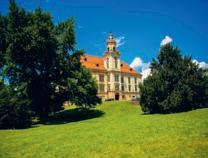
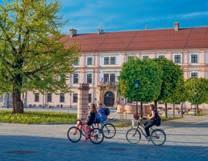

Land and water (this page; clockwise from bottom left) The Prandau-Normann Castle in Valpovo now serves as a museum about the area; cyclists and canoeists side by side on the Amazon of Europe trail; cycling the forests on Psunj, the one of the highest mountains in Slavonia; pedalling Osijek’s Old Town Alamy; Bojan
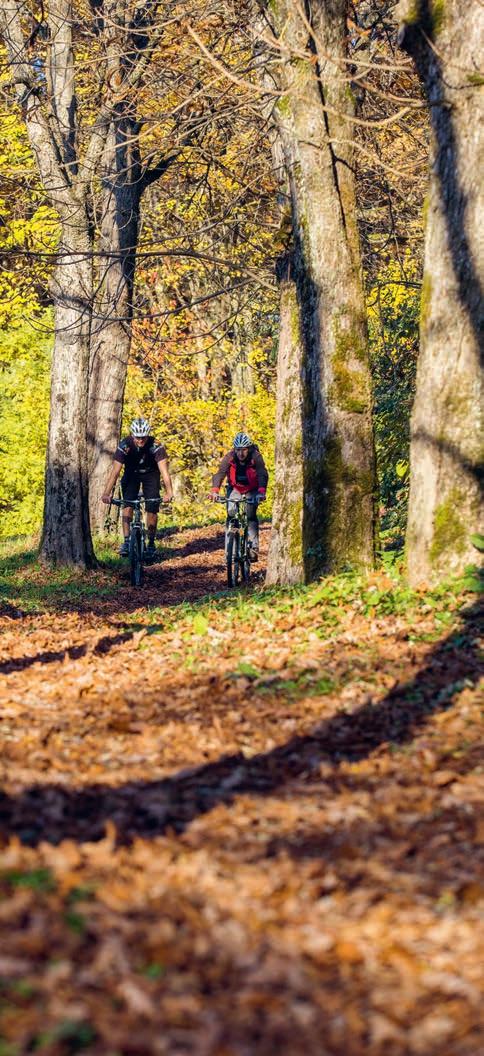
3 wild sightings

1 European pond turtles
Bike around Slavonia’s wetlands to see European pond turtles sunning themselves in the shallows. These freshwater reptiles are easy to spot thanks to their yellow-speckled shells. In summer, the turtles feast on the region’s hundreds of species of moths, beetles and dragonflies. In winter, when temperatures plummet, they hibernate in the mud.

2 White-tailed eagles
One of around 300 avian species seen in Kopački Rit, white-tailed eagles hunt on the River Drava. Europe’s largest eagles are cunning opportunists and will bag a pine marten, a pike or even a passing heron given half a chance. Pairs mate for life, building massive nests that they recycle year after year.

3 Dice snake
Several types of snakes can be seen in Slavonia’s wetlands. The dice snake, in particular, is at one with the water. Look out for their skinny bottlegreen bodies in oxbow lakes and shallow meanders. When threatened, dice snakes dive deep or release a foul stink to deter predators.

Lunch sent me into an early slumber. After a doze under an ancient oak tree, I continued the stage. Kingfishers flitted to my left, darting like iridescent arrows. Otter paw prints adorned the riverbanks. It was an Edenic ride.
Most stages on the Amazon of Europe trail are around 32km long. It’s just enough distance for a slow cycle interspersed with wildlife and sights. I finally arrived, slightly dishevelled, at the Kurija Janković heritage hotel. Fortunately, like every Slavonia hotel, the receptionist had welcomed mud-splattered cyclists before. The establishment has a bike repair station, 15 bikes to rent and links to 12 licensed cycle guides in the region. Slavonia is made for two wheels.
BIKES, BEER AND BIRDS
Stage S12 was my favourite. I began the day with a breakfast of štrukli (stuffed pastries) in Belišće. It seemed that everyone in this age-old town was pushing a bicycle, carrying a fishing rod or portering a kayak. My first stop was Valpovo. It’s famous for its summer festivals, craft beer and venison from the local forests. I’m a big fan of all three.
The day’s highlight was my cruise into Osijek, Croatia’s fabulous fourth city. It’s an Austro-Hungarian gem ringed by fortress walls that command the banks of the River
Drava. Within sit cafés, museums and a vibrant food scene that redefines Slavonian delicacies – local bean mash, red pepper avjar, čobanac game stew – with a contemporary twist. My bike-friendly hotel, the Maksimilian, was built into the city walls in the 18th century.
At dinner, I met Ivan Smoljanac, one of Croatia’s most passionate cycling guides, who studied in Osijek. One attraction to him was his university’s proximity to the Osječko brewery, the first-ever beer produced in Croatia. Smoljanac told me about his favourite stages in Slavonia’s gently hilly west and flat east.
“But everywhere is great because you are cycling through culture, through cuisine,” he explained. He talked about Tikveš Castle in the wine region just north of Osijek, home to deer trails and waterlily boardwalks. The following day, however, my plan was to just follow the birds.
Kopački Rit is where the Drava meets the mighty River Danube, resulting in a waterworld of ancient lakes. Great white egrets swooped, white-tailed eagles soared and black storks, fresh from their migration from India, splashed down onto the backwaters. In this awe-inspiring nature park, I was happy to swap my bike for an electric boat for an hour, content to drift the waters in peace.


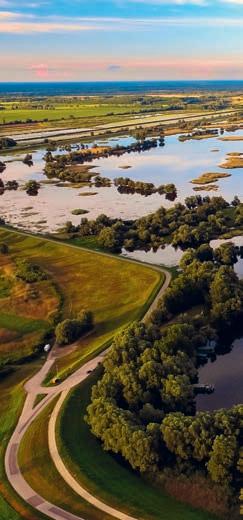
On two wheels (clockwise from top left) A rutting stag in Kopacki Rit Nature Park; paddling the wetlands; cyclable roads run throughout Slavonia; Papuk is a UNESCO-protected geopark; Kopacki Rit is home to nearly 300 bird species; the sandy riverbank of Poloj; Tikveš Castle
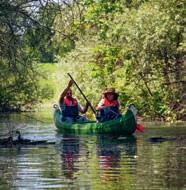





3 more Slavonia cycle routes
1 Graševina cycling route
The 17km ‘Graševina’ cycling route loops through Slavonia’s wine country. Bikers can begin at Kutjevo, one of Croatia’s wine capitals, where a band of booze-loving monks planted vines eight centuries ago. The same terroir that raises zinging white wines – a plain elevated 400m above sea level, cooled by daily breezes – is perfect for cycling too. Take a break at Kutjevo winery to sample white wines made from the graševina grape.
2 Papuk
Papuk is a UNESCO-protected geopark. This nature reserve features one of Slavonia’s highest mountains. Down below, find limestone meadows beset with orchids and clover, streams alive with otters and crabs, and a dense fairy-tale forest thrumming with woodpeckers. Visitors can try treks, geocaching, riding, canoeing and via ferrata climbs. The ultimate experience is to download the cycling trail from pp-papuk.hr onto your phone, which marks a mountain bike map through the park.
3 Vallis Aurea
Romans called this abundant area Vallis Aurea, the ‘Golden Valley’. A 101km cycling circuit starts in the Baroque town of Požega, in Slavonia’s hillier west, then rises on asphalt roads and heads deep into the forest. The most telegenic section soars through the vineyards on the southern slopes of Mount Papuk. The final waypoint is Lake Sovsko – known as ‘the Blue Eye of Slavonia’ – which features a lot in Croatian legend and is alive with creaking frogs and singing warblers.


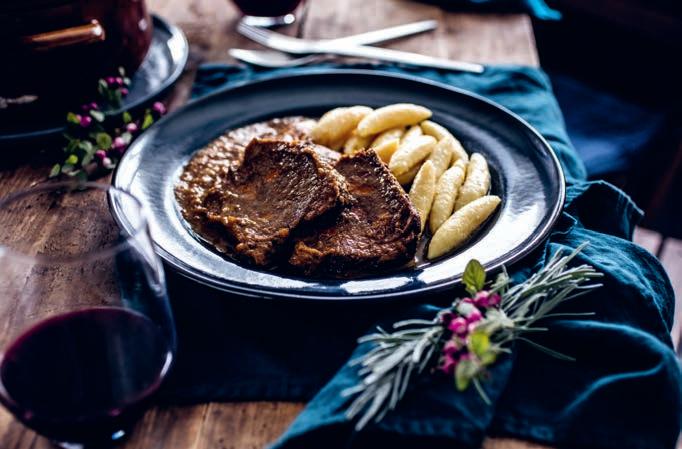
A gourmand’s guide to Croatia
Rachel Truman guides us through culinary Croatia
Simplicity and tradition define the cuisine of Croatia, a country blessed with a bounty of fresh produce from sea and land. There is diversity too; its culinary landscape has been shaped by countless influences and a varied geography.
The coastal cuisine has distinct Mediterranean influences, most notably from the Venetians, who left a legacy on the food as well as the architecture. Handmade pasta, gnoc-

chi and risotto (often glossy and black from cuttlefish ink) are all part of the Dalmatian repertoire. A typical meal at a coastal konoba (tavern) might also feature sardines, octopus or a whole grilled bream or bass, accompanied by chopped blitva (chard) and potatoes. Consider pašticada while you’re there – a succulent, braised beef dish cooked in a sweet and sour sauce. Add a platter of pršut (ham) and a glass or two of Plavac Mali wine.
Brodet, a delicate seafood stew, is a defining
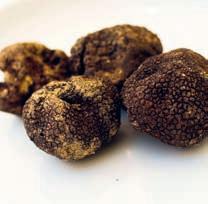
dish in the Adriatic regions too while pašticada (slow-cooked beef) with njoki (gnocchi) is a specialty of Split.
Head into Dalmatia’s rugged hinterland where the food gets heartier to match the landscape. Think pies like the region’s soparnik (a thin chard and onion pastry) and smoked sausages.
Go inland in the region of Kvarner and you’ll find freshwater fish, frogs, snails and game, while Kvarner Bay is best known for

Produce of sea and land (clockwise from top left) From its meats to its wines, local produce is celebrated by chefs and on menus across Croatia; feast on freshly caught shellfish; the traditional pastry dish Zagorski štrukli is a nationally protected intangible cultural asset of Croatia and is also protected by the EU; be sure to taste the local truffles when in Istria; soparnik is a must-try when visiting Dalmatia’s hinterland
Alamy; Maja Danica Pečanić; Ivo Biočina
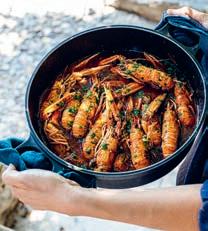
its scampi. On Krk, you’ll find these plump pink beauties paired with šurlice (pasta) and its celebrated white wine, vrbnička žlahtina
The seafood is a reason to visit Rab too but it’s the island’s renowned Rapska torta (Rab cake) that you’ll want to take home.
Tangy sheep’s milk cheeses, handmade in small dairies on Krk, Cres and Lošinj, are other must-tries but it’s Pag in the Lika-Karlovac region that produces the country’s most famous cheese. This sheep’s milk cheese gets its flavour from the island’s salty wind and aromatic pastures. Culinary traditions are deep-rooted on Pag: its wine žutica has been made here since Roman times, as has olive oil — some of the olive trees are thousands of years old.
Heading north, Istrian pršut prosciutto is greatly revered. Dry cured and unsmoked, it has been made this way since ancient times. Another draw for the gourmet peninsula is the truffles that proliferate in its forests. Autumn marks the start of the white truffle season (black ones are found year-round), with Buzet the place to enjoy the delicacy shaved over pljukanci and fuži (Istrian pasta shapes), njoki and steaks.
No Croatian celebration is complete without štrukli.The cafés in the capital, Zagreb, are a great place to try this pastry speciality from the Zagorje region to the north, along with other favourites such as the Zagreb schnitzel and roast turkey with mlinci (a flatbread). Rural customs run deep in Central Croatia and Slavonia, with full-flavoured rustic dishes making the most of produce grown on their fertile plains. The influence of Austro-Hungarian cuisine can be seen here with dumplings, krpice sa zeljem (pasta with cabbage) and paprika-spiked stews all typical dishes. Musteats in Slavonia include fat-speckled kulen (cured sausage), fiš-paprikaš (freshwater fish stew) and savijača (apple and walnut pastries). As this is one of Croatia’s main wine-growing regions, you can be sure of a tasty tipple, too. Živeli!
The stars of Croatia
This food-obsessed nation has been awarded many Michelin stars. Here’s where to find them…
1 Boškinac
Set within a family-run hotel on Pag, this restaurant is enveloped by vines and olive groves. The menu uses the isle’s local larder – think lamb, Paški sir (Pag cheese) and octopus – best paired with the hotel’s own sparkling wine, Viaz.
2
Nebo by Deni Srdoč
Sophisticated cooking meets smart surrounds at Nebo, a rooftop restaurant in Rijeka. Chef Deni Srdoč’s tasting menus celebrate ingredients from around Croatia.
3 Noel
One-starred Noel is Zagreb’s hottest table. Its tasting menu changes to reflect the four seasons.
4 Pelegrini
A contemporary interpretation of centuries-old Dalmatian recipes defines the six-course tasting menu at Pelegrini. Set in a 14th-century palazzo, the setting oozes tradition, but chef Rudolf Štefan’s techniques and presentation are very modern.
5 Alfred Keller
Prime Lošinj produce is elevated further by chef Michael at Alfred Keller, the one-starred restaurant of Alhambra Boutique Hotel. Signature dishes include Adriatic fish with fennel kulen and scampi tartare.
6 Agli Amici Rovinj
Overseen by Italian chef Emanuele Scarello, Agli Amici Rovinj was awarded two Michelin stars in 2024. Sit on the terrace overlooking Rovinj’s marina and let one of the two tasting menus, Rovinj (seafood) and Istria (meat), tell the story of the regions through seasonal ingredients, all sourced from small producers.
7 Restaurant 360
Dubrovnik-born chef Marijo Curić steers the expert kitchen crew at Restaurant 360, which has two tasting menus and a la carte options. The Republika tasting menu puts a
modern spin on the heritage dishes from Dubrovnik’s Renaissance era including Popara 2.0, Curić’s riff on an ancient fish stew recipe.
8 Monte
Monte in Rovinj was the first restaurant awarded a Michelin Star in 2017. When chef Danijel Đekić took over from his parents, he transformed the Istrian tavern into a gastro hotspot but retained its link to regional traditions and small, local producers.
9 Dubravkin Put
Dive into the flavours of continental Croatia at Dubravkin Put, just outside Zagreb’s centre. Prime ingredients (think wild asparagus, pheasant and salmon trout) are cooked with an elegant simplicity.
10 LD Restaurant
This waterside restaurant stretches along the medieval walls of Korčula’s old town. Part of Lešić Dimitri Palace, LD Restaurant’s kitchen is helmed by Marko Gajski. Ingredients such as bluefin tuna are showcased in a three or six-course tasting menu.
11 Korak
Overlooking the vineyards of a historic winery, Korak celebrates the terroir of the Plešivica region. Think mushrooms, freshwater fish and foraged herbs. It has a Michelin star and a green star for its sustainability.
12 Cap Aureo
This Rovinj restaurant, ran by Chef Jeffery Vella was awarded a star in 2025. Highlights include the monkfish with mushroom sauce, the well-curated wine-list and the mesmerising views over the old town.
13 Krug
At the centre of this restaurant in Split is the kitchen, where you will be sat directly in front of the cooks who will talk to you about the history of the dishes as they serve it to you. Ingredients are locally sourced and everything is prepared in-house.

A flavour of the Med
Mediterranean Croatia is arguably best explored at the dining table, as Rudolf Abraham discovers…
How to distil more than 25 years’ worth of memories of delicious Croatian cuisine into just a few paragraphs? In doing so, I found that they were all inevitably rooted in a sense of place.
I thought back to the first time I tried pašticada, a traditional Dalmatian dish that is opulent almost beyond belief. Made from beef marinated in prošek (a local dessert wine), simmered for an eternity with dried plums and served with fresh gnocchi, I recalled trying it in a village near Zadar, sitting at a table in the shade of a gnarled tree.
A plate of freshly made pljukanci (a traditional type of Istrian pasta) also came to mind, tossed in cream with shavings of
heavenly tartufi (truffles). Paired with a lovely bottle of local Malvazija, I tried this at a small konoba (tavern) in the heart of rural Istria.
Some of the best food memories were the simplest. I thought back to a salad made from fat, still-warm beefsteak tomatoes picked from a garden in summer. Another that stood out was a dinner of sea bass in an olive grove overlooking the sea near Punta Skala. As I ate, dolphins flicked through the water in the halflight. Croatia and its food are inseparable.
OLIVE OIL
Olive oil, more than any other ingredient, is the backbone and the lifeblood of Mediterranean cuisine. It’s no different in Croatia, where Greek colonists planted olive groves on the

Croatian coast and islands as far back as the fourth century BC. These days, for Croatia’s finest olive oil, you need to head to Istria, which has a fine reputation for its oils.
I’d heard about Novigrad’s Al Torcio oil mill years before I visited it.The first Croatian olive oil producer to be listed by the prestigious Flos Olei guide 20 years ago, they pretty much put Croatian olive oil on the map.
Mate, near the village of Zambratija, is another award-winning olive oil producer. It also runs tastings for visitors, which are the best way to appreciate the incredible depth of flavour of Istrian olive oils. You’ll get to sample some superb oils made from ancient varieties of Istrian-grown olives such as bjelica, buža and karbonaca.
Ivo Biočina

WINE
Wine is another indelible part of Mediterranean heritage, and it forms the DNA of most Croatian gastronomy. For full-bodied, inky reds, look to the Dingač region on the Pelješac peninsula. For whites, try grk from the island of Korčula, or žlahtina from Krk. But the be-all and end-all of Croatian wine regions is arguably the north-west corner of Istria, famed for its Malvazija and autochthonous teran grapes.
Oenophiles should arrive in time for 11 November to enjoy the St Martin’s Day celebrations, when the must (pressed grape juice) officially becomes wine. For the rest of the year, settling down for a wine tasting at some of Istria’s small, family-owned vineyards is the way to go. Among the most prestigious is Benvenuti in Kaldir – and if you only ever try one dessert wine in your lifetime, make it their Muškat San Salvatore. Damjanić in Fuškulin is another winery worth savouring; one of the highlights there is its Akacija wine, a Malvazjia aged in an acacia barrel.
For an illustration of terroir, visit Cattunar near the village of Nova Vas. It is situated on the boundaries of four soil types, and its four Malvazija styles taste so different from one another that you would never guess they were all made from the same grape.
SEAFOOD
When it comes to seafood, brodet is the quintessential taste of the Adriatic. This rich stew, typically served with polenta, is made with several varieties of fish and shellfish. Also try the slow-roasted octopus, cooked using the ispod peke method (in a shallow iron dish beneath a lid sprinkled with hot coals).
For pure and simple seafood, order the grilled fish. This is typically anointed with finely chopped garlic, olive oil and parsley, and served with potatoes and Swiss chard. Look for darker-fleshed fish: mackerel and sardines are a more sustainable choice, since these species are pretty common to the region; they are also richer in omega-3.
Most places on the coast and islands have ‘fisherman’s festivals’ in the summer months, which are essentially a party on the waterfront with lots of grilled seafood on offer, live music and plenty of wine. And for an authentic experience, take a stroll through a ribarnica (fish market), which are generally at their liveliest on a Friday morning.
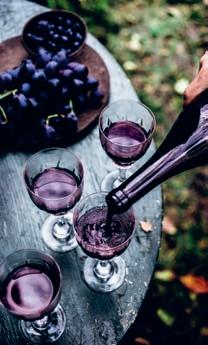

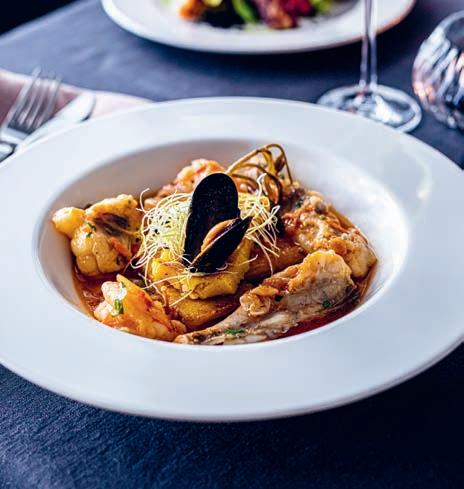
A taste of Croatia (clockwise from opposite page, top left) For a classic and simple Croatian dish, order grilled fish; olive trees have been growing in Croatia since the fourth century BC; the Pelješac peninsula is home to full-bodied red wines; be sure to order brodet in Croatia, a rich seafood stew loved by locals and visitors alike; sample local olives on a tasting tour in Istria; pljukanci, a traditional Istrian pasta that comes topped with truffles, is a must-order


At the chef’s table:
In conversation with Bernard Korak

We wanted to renovate it, and originally we were going to hire a chef. But I thought: we are not going to hire anybody! We are a small, family-run business, so I just started working as a dishwasher, and then I graduated to a chef’s position during my education.
What about your commitment to the local area?
The best way for us to tell our story is through the location and the ingredients we can obtain here (the Zagreb County region), by producing it ourselves and also by planning with other growers and farmers in the region. We try to change our menu to match the seasons. As the season changes, new ingredients become available to us and this inspires the menu.
At Korak restaurant in the Plešivica region, family and farm-to-table food is everything. Despite being open for just five years, the restaurant has already bagged a Michelin star along with a Michelin Green star. Wanderlust editor-in-chief George Kipouros visited the vineyard-clad eatery for himself and caught up with co-owner and chef Bernard Korak…
Can you tell us about the history of Korak?
Historically, as a family, we have always been in vineyard production. Our vineyards have been passed down from generation to generation. There have always been vineyards here, and in the 1990s, my father started producing and selling high-quality wine. He was one of the first people to start making wines in the Plešivica region, which is now a very well-known wine-making area in Croatia. As the next generation, my
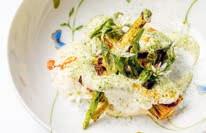
brother, my sister and I wanted to use our experience of working on the family estate, so we opened a restaurant five years ago.
It was never our intention for it to be a fine-dining restaurant; it was just something that came from my education as a chef. I actually started cooking when I was 28. I was studying civil engineering before that and working as an engineer.
Before we had the restaurant, all we had was a small traditional place which was run by my mother and my grandmother.

We have to work really hard when planning, particularly in winter when produce becomes scarce here and the menu features more fish and meat. We have three gardens that we use to grow the vegetables for the restaurant. As the summer season starts and our gardens begin to grow, we more or less use only the vegetables that we produce ourselves. So we are a proper farm-to-table restaurant!
And your whole family is involved. That was a big surprise for me, as it’s a proper family experience. Of course! Everybody contributes here. Our gardens are maintained by my mother. My grandmother is 83 years old, and she still makes some of the ingredients that we use, including the cheese, which is made two times a week and served to our guests.
My brother and my father run the winery side of our business, and my sister and I do the hospitality. Before we opened the restaurant, we didn’t have any employees; it was all done in the family. We had all worked in the vineyards previously, so it is very much a family business.
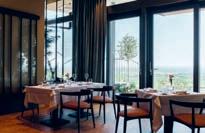
A rising star (clockwise from top left) Chef Bernard Korak previously worked at the three-Michelin-starred Hiša Franko in Slovenia and Osteria Francescana in Italy before returning to Croatia to open Korak; the restaurant and winery are run by the Korak family [pictured]; Korak was awarded its first Michelin star in 2023; the restaurant overlooks the beautiful landscape of the Plešivica region; the winery has been in the family for generations; Michelin-starred delights
Korak Winery; Mario Kučera’s; Mateja Vrković; Sanja Jagatić



Sand, sea and salt in Pag
Salt, or ‘white gold’, has been produced on this photogenic Croatian island for over a millennium – and now visitors can get involved, reports Richard Mellor
At first sight, Pag appears prehistoric. Just an hour from Zadar, and scored by two mountain ridges, it’s a 64km-long finger of limestone set stark against the mineral-blue Adriatic. However, closer inspection reveals picturesque towns and the glinting, watery lattices of salt flats.
Visitors can access Pag, Croatia’s fifth-largest island, either by ferry or via a 301m-long road bridge. Aside from a few scattered villages, it has two main settlements: Novalja, famous for its clubs and nearby electro festivals, and the sleepier, cathedral-crowned Pag Town. Hardy sheep outnumber residents by four to one; hikers and cyclists are the other free-roaming anomalies, crossing silent, sage-studded flanks towards ruined Byzantine forts or empty pebble beaches. And these mesmeric landscapes often come with a whiff of salt…
SALT TOURS AND SPAS
So-called ‘white gold’ has long shaped Pag’s identity. While records trace salt production on the island to 999 AD, it’s widely accepted that it was harvested here during Roman occupation, when it was used to pay soldiers (hence the word ‘salary’) or traded for gold.
Later, the Venetians cannily monopolised all Adriatic coastal saltworks. That included Solana Pag, which remains by far Croatia’s largest producer. Its faintly sweet-tasting sea salt is made using evaporation techniques that the Romans would no doubt recognise.
“During winter, the 210kph bura winds leave Pag covered in salt,” explained Igor Orešković, Solana Pag’s head of sales. “Where the continental part of Croatia has frost, we have salt.”
Visitors can be shown around Solana Pag’s expanse of pans and pools, near Pag Town, learning about the history of salt on the island, tasting gourmet fleur de sel – the crust of evaporating seawater – and even collecting salt themselves. Requested in advance, tours take place at 7am from June to September (solana-pag.hr).
“This is also a Natura 2000 area,” added Orešković. “As well as the Mediterranean toothcarp, there are also more than 200 bird species found on our estate.”
Try to drop by the permanent exhibition on salt production, a small museum that is set amid nearby Pag Town’s old stone warehouses. Or sample some salt-based halotherapy at the Camping Village Šimuni.
TASTE MORE OF PAG
Salt is not the island’s lone delicacy. Pag cheese is an acclaimed sheep’s milk concoction, whereas spit-roasted Pag lamb is a much-loved delicacy and the island’s staple dish. But the influence of salt is never far.
“Many products here reflect its abundance,” said Darka Šćerbe Haupt, a local tour guide. “However, the island also has many other interesting foods, from baškotini, aromatic rusks made by Benedictine nuns, to oil from Lun, where you’ll find some of the world’s oldest olive trees.” There’s plenty to savour on Pag.
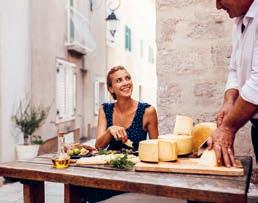
Salt island (clockwise from top left) Pag’s Beritnica Beach is famed for the three giant rocks found in its shallows; salt has been harvested on Pag island in the same way for centuries; the ancient olive gardens of Lun are famous for their oil; the island’s salty sheep’s cheese is often compared to Manchego or comte in flavour
On the trail of the vine
Slow down and soak up the Slavonia region’s vineyards, says Tristan Rutherford

Long before the Romans brought grapes to regions such as Bordeaux in France, ancient civilisations venerated Slavonia’s terroir. That’s because this eastern corner of Croatia is one of the world’s most perfect grape-growing zones. Its elevated plains are licked by sunshine and left to soak up minerality from three mighty rivers: the Danube, Drava and Sava. When the Roman emperor Marcus Aurelius Probus arrived in Slavonia, he immediately set about planting more vines.


In the 13th century, Cistercian monks settled around the pretty town of Kutjevo. This religious brotherhood wove wine into Slavonian culture, a tradition that continues in the form of festivals, heritage and song. Today, as many as 350 wineries welcome curious drinkers, while thousands more families produce their own rare vintages.
GOING UNDERGROUND
The golden-green vineyards around Kutjevo, Ilok and other wine-making towns are deeply intertwined with the cultural fabric of Slavonia. Kutjevo features Croatia’s oldest wine cellar, dating back to 1232. The winery’s underground wine tour is like stepping back in time. Visitors can taste their way through a historical cellar stocked with 65,000 bottles, the richest wine archive in the country. Up above, the new restaurant Vinkomir is situated among the rippling vines. Wine-infused dishes include gnudi cottage cheese fritters with grape oil dipping sauce.
The Kutjevo region is stocked with similar experiences at age-old cellars. Local grape



varieties like graševina (commonly known as riesling), the region’s most widely planted white wine vine, have grown here so long that they are considered indigenous, and Plavac Mali offers a robust flavour. Family-owned estates like Enjingi, near the village of Hrnjevac, offer tours of their vineyards. They can also organise nature walks, bike rides and Slavonian feasts baked in a brick oven.
A TASTE OF LOCAL LIFE
In Ilok’s medieval town centre, there is a tasting room on almost every street. The Iločki winery, for example, has cellars that date back to the 15th century. The vineyard is particularly famous for its traminac wines (also known as gewürztraminer), which were served at the coronation of Queen Elizabeth II. A 10km-long ‘wine road’, or vineyard trail, runs through the surrounding countryside and a dozen wine-growing estates. With advance notice, each one will offer a private tasting alongside a platter of

Slavonian cold cuts. The wine road meanders past Odescalchi Castle, now a museum, where European aristocracy once sipped Slavonia’s finest vintages.
Slavonia’s wine-making heritage is celebrated in a number of free-flowing festivals. Most feature music, food pairings and al fresco tastings. The Vinkovo festival in Ilok is a five-day party enlivened by street grills and vineyard tours by horse-drawn carriage. The St Martin’s Day (Martinje) celebrations in rural villages bless the harvest with live folk music and open cellars.
Finally, temperatures in Slavonia from late spring through autumn are warm and sunny, a fact proven by the region’s prodigious grape production. It’s the ideal weather for mountain biking, vineyard hiking and many viticultural experiences.
Ask a local
“We offer guided tours of the old wine cellar, which dates from between the 15th and 18th centuries. Different tiers of wine tastings are offered too. We also offer tours through our vineyards, namely Principovac and Vukovo, via our electric tourist train, the Traminac Express.”
– Vesna Štajner from the Iločki Podrumi winery
“In our region, you can visit cellars and stay overnight in a historic property.”
– Tomislav Panenić, director of Graševina Croatica, Slavonia’s largest winemakers association
Three more wine regions to explore
1
Istria
Istria is a heart-shaped region of northern Croatia covered in vines. Think olive groves, truffle hunters, Roman ruins and undulating vineyards. Istria’s stand-out grape is malvazija istarska. Few varieties absorb such a mineral-rich terroir, which is turned into blossomy, almondy white wines. Among Istria’s 250 immensely welcoming wineries is Kozlović, which has a boutique restaurant and wine bar among the vines.
2 Korčula
Pošip is a white grape native to Korčula and was the first Croatian white wine to receive protected status in the 1960s. Today, its citrus pop can be sampled at authentic agricultural co-operatives like Čara. Grk is another grape that grows here and was planted by the Ancient Greeks some 2,000 years ago. The variety, which has a sharp, saline whipcrack, loves sunshine and sand. Since then, every empire, from Rome to Austria, has left another viticultural legacy here.
3
The Pelješac peninsula
The Pelješac peninsula, near Dubrovnik, rears once-ina-lifetime red wines. Grapes cling to the peninsula’s sheer cliffs, where they soak up some of the nation’s most relentless sunshine. The heat is re-released from the stone at night, pushing alcohol volumes up to 16%. But be warned: production is so low here that visitors will be hard-pressed to find vintages outside of family wineries such as Mikulić, which has its own on-site wine history museum and lodgings.
Land of grapes and glory (clockwise from this page) The town of Ilok is watched over by the Odescalchi Castle, which houses a warren of wine cellars; Ilok has a rich winemaking history; Kutjevo Castle is built on the remains of the Cistercian Abbey that once stood here; embark on an underground wine tour in Kutjevo; Kutjevački Podrum is one of the oldest wine cellars in South-East Europe; follow the 10km wine road in Ilok to explore the area’s viticulture heritage
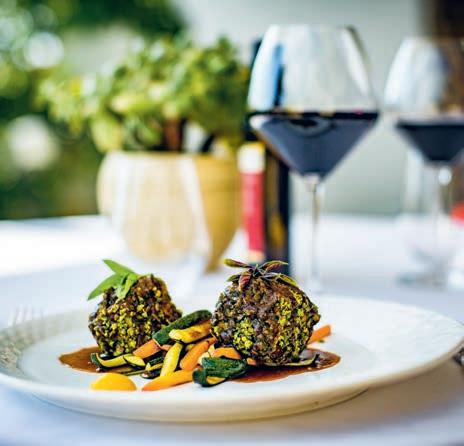
The joy of slow food
Forget fast food. As Rudolf Abraham swiftly discovers, Croatian dining is all about slow pleasures
Discover the most authentic side of Croatia’s cuisine by taking time to head off the beaten track to uncover lesser-known food routes, enjoy culinary experiences and meet the locals. At its best, slow food in Croatia fuses a wealth of local, seasonal ingredients with a profound respect for tradition and terroir. In the words of Tea and Stiven Vunić, owner-chefs at Konoba Zijavica in Mošćenička Draga: “Authenticity is key”…
GET AN AUTHENTIC TASTE OF ISTRIA
If slow food in Croatia has a heart, it’s Istria. Here, fresh seafood, game, heavenly truffles and seasonal delicacies such as wild asparagus and cherries, along with some of the finest olive oil found anywhere in the world, all come together to create something very special indeed. “Our task is to respect and
extract the best from all of these wonderful ingredients that our land has always offered us,” says Teo Fernetich, chef and owner of San Rocco restaurant and hotel in Brtonigla. And the best way to experience Istrian cuisine at its most authentic, you ask? Head inland. Taste melt-in-your-mouth pršut (dry-cured ham) in Tinjan, outstandingly good pasta dishes pretty much anywhere (not surprisingly, given several centuries of


Venetian influence), wonderful wines from vineyards including Benvenuti, Damjanić and Fakin, and olive oils from the likes of multi-award winning Al Torcio and Mate.
MEET SLAVONIA’S FARMERS
Travel across the fertile plains of Slavonia in summer and the landscape is awash with greens and golds from two of the region’s main crops — corn and sunflowers. But the region’s signature food is kulen – a smoked, cured pork sausage made with the finest cuts from the local breed of pig, along with pepper, garlic and paprika. Hand-shaped in a natural casing, it’s smoked for a month and then cured for up to six months, has an irresistibly smoky-spicy flavour and has been granted Protected Designation of Origin (PDO) status.
Paprika is a defining ingredient in many traditional Slavonian dishes – try fiš paprikaš, a deliciously rich and spicy carp stew, and perkelt od soma, a stew made with catfish. For dessert, don’t miss tačkrle – traditional, plum jam-filled dumplings smothered in browned butter and fried breadcrumbs.
VISIT THE VINEYARDS OF PLEŠIVICA
The Plešivica wine region lies not far from Zagreb – a rolling, vineyard-clad landscape on the southern side of the Žumberak hills. Rhine Riesling, Sauvignon Blanc, Chardonnay and Sylvaner Verde are some of the main wines produced here, and the organic Korak Winery is also known for its Pinot Noir. But it’s with sparkling wines that Plešivica has become particularly associated.
There’s no shortage of farmed or foraged produce from the surrounding region either – the mushrooms here are particularly prized – meaning there’s also plenty of delicious local food to try. This is a place where, to quote chef Bernard Korak, “the local cuisine mirrors the natural bounty of its surroundings”.
SEE HOW CHEESE IS MADE IN PAG
Paški sir is a hard, exceptionally tasty sheep’s milk cheese from the island of Pag, with
PDO status. It owes its distinctive flavour to the sparse vegetation which this rocky island’s sheep graze on – a diet which includes plenty of herbs and a good dusting of Adriatic salt, blasted over the island by the Bura wind. You’ll find Paški sir in restaurants and on market stands all over Croatia – but for the best experience, join a cheese tour or tasting on the island of Pag itself. Family-run Gligora, in the village of Kolan, is now in its fourth generation of expert cheese-makers and offers insightful tours and tastings.
STROLL THE MARKETS OF ZAGREB
Dolac – Zagreb’s large, vibrant central market – remains the beating heart of the Croatian capital. It stands on two levels just behind Ban Jelačić Square – a location it has occupied since 1930, although the history of Zagreb as a market town stretches all the way back to the 13th century. Chances are, if you’re a local, you’ll do at least some of your shopping here. And as a visitor, well, if you haven’t seen the market, you haven’t truly seen Zagreb.
In the years I lived here, my weekly routine revolved at least in part around the phrase ‘Idem na Dolac’ (‘I’m going to the market’). The upper terrace has open-air
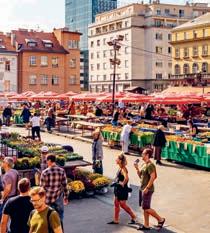
stalls heaped with fresh fruit and vegetables, with the fish market on one side; meat and dairy produce is on the lower, covered level. Open from early morning until early afternoon, Dolac is at its liveliest on Fridays.
CYCLE FOR YOUR SUPPER IN LONJSKO POLJE
Lonjsko Polje is one of the largest preserved natural floodplains in the Danube basin. The River Sava unravels itself across this sprawling, verdant landscape like the coils of a silvery blue snake, framed here and there by oxbow lakes, and small villages

where storks make their ragged nests on the rooftops of traditional wooden houses. The quiet country roads and tracks hereabouts are perfect for cycling, with stops at rustic, family-run guesthouses and restaurants in villages such as Čigoč and Lonja. Expect to find plenty of freshwater fish on the menu – grilled carp is really the one to go for here – along with hearty traditional fare such as venison goulash, and posavski lonac (a meaty, slow-cooked stew). Wherever you are in the country, you won’t regret slowing down and spending some time to truly savour the food.

Authentic cuisine (clockwise from top left) Pairing fine food with locally-produced wines is standard practice in Istria; be sure to sample Slavonia’s kulen, a type of cured sausage made from pork; Zagreb’s Dolac Market first opened in the 1930s; Lonjsko Polje is central Croatia’s largest natural park and a haven for birdlife; meet the locals to see how food is produced and prepared; Pag’s sheep’s milk cheese has been given PDO status

Coastal escapes
Croatia’s coastline spans more than 6,000km and more than 1,200 islands – many with their own unique culture and heritage. We shine a light on the places that are far more than just a pretty shoreline


Hidden isles
Robin McKelvie reveals five secret Croatian outcrops
If your idea of a paradise island includes escaping the crowds, ditching cars to explore the beauty of nature on foot and uncovering truly authentic, local experiences, then you’re in the right place. Read on to uncover five secret islands well worth exploring...
1
OLIB
Swap your shoes for sandals and slip into Olib time. It is easy to see why this bijou charmer north-west of Zadar was a favourite with the Greeks, Romans and Ottomans, who once bathed in these crystal clear waters. Historic legacies linger, like a quartet of churches – the Church of the Assumption of the Blessed Virgin Mary stars with its 17th-century Glagolitic scripts. Also worth exploring are the romantic ruins of Saint Paul’s Church and Monastery.
The island’s wines, olive oil and cheese seldom leave Olib so you’re in for an exclusive treat. Getting around is also fun as the main mode of transportation on car-free Olib is golf carts.
2
PRVIĆ
This idyllic isle may be easily accessible from Šibenik – it’s the first (prvić means first) isle you come to – but it feels a million miles from the city. Its other moniker is ‘Faust Island’, after Faust Vrančić, a remarkable genius who invented the parachute, suspension bridge and cable car. Delve deeper into his fascinating life at the Faust Vrančić Memorial Centre.
If you’re after cute villages, Prvić harbours two in sleepy Luka and Šepurine, so close to each other that locals simply stroll between them. The scent of lavender eases across this


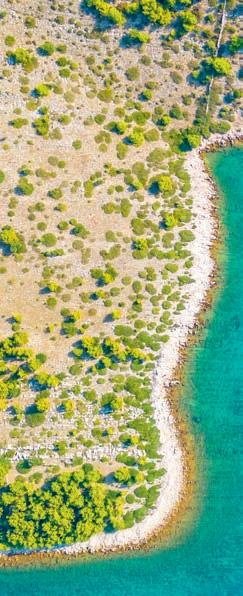
Sheltered escapes (clockwise from top) Lesser-known Olib has been dubbed the Adriatic King of sandy beaches; secret Susak is at the end of Kvarner Bay; Zlarin’s protected harbour makes it a good anchorage for sailors; Žut is a wild and uninhabited isle; Šepurine harbour is a peaceful spot on Prvić



isle, where simple pleasures, like savouring fresh seafood and swimming in empty coves, will make you glad you discovered this secret slice of the Adriatic.
3
SUSAK
Dreaming of an escape to a secret isle scattered with sandy strips where you can unfurl your towel, untrammelled by the modern world? You’ll find it in sleepy Susak. You’ll be in good company, too as Jason (of the Argonauts fame) once sought refuge here.
Head into the narrow streets of the eponymous village of Susak to sample the wine. The red pleskunac or dry rosé trojiśćina are both must-trys. The village is split between Gornje Selo, the older settlement housing the island’s church, and Donje Selo down by the bijou harbour.
Look out for islanders proudly sporting traditional dress before joining them to feast on boat-fresh seafood and losi, a fried pastry deliciously spiced with lemons.
4
ZLARIN
There may be no cars on Zlarin, an island within touching distance of Šibenik, but there is plenty of coral. This has earned Zlarin many monikers – Golden,
Green and Coral Island. The coral is put to great use on an island renowned for working wonders with coral as far back as the 15th century. Ease off on a golf cart to the local museum to learn more.
There is plenty to explore in this secret corner of Dalmatia, including the Church of Our Lady of Rašelj and the Church of the Assumption. Mother Nature offers magic too with tempting beaches, thick pine forests and wee bays you’ll often have completely to yourself.
5
ŽUT
George Bernard Shaw appreciated the beauty of the Kornati Islands, eulogising “On the last day of creation, God desired to crown His work, and thus created the Kornati islands out of tears, stars and breath”. You don’t forget a visit to islands like Žut, the largest uninhabited Croatian island. They say in this part of the world every house has a restaurant and it feels like that in the Kornatis. Mooring a yacht up in a quiet cove and then savouring boat-fresh seafood in one of the simple restaurants is a quintessentially Kornati experience. There is also a marina where you can hide away from the world, making your island escape feel all the more secret.
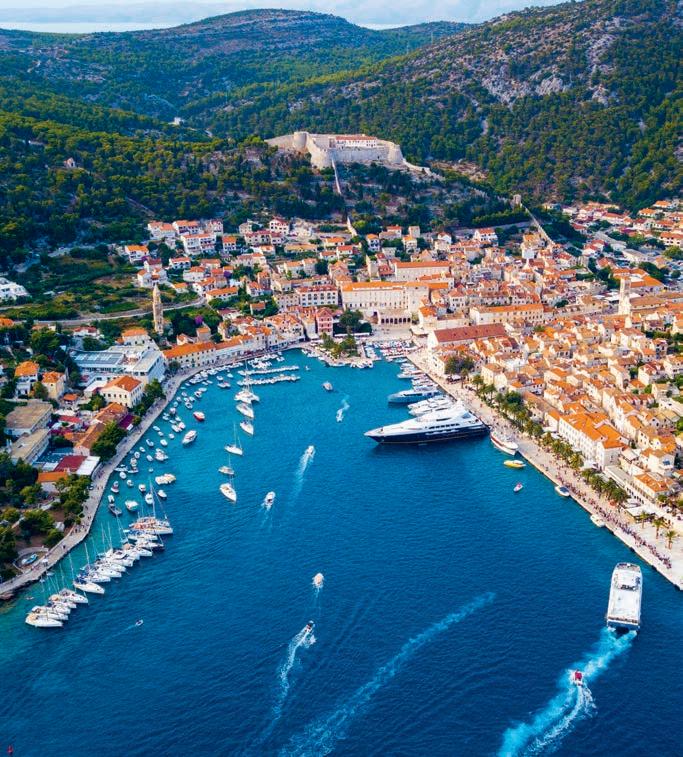
History and heritage in Hvar
This culturally rich Croatian island is brimming with an array of stories, traditions, crafts and UNESCO-listed sites. Wanderlust’s special features managing editor, Rosie Fitzgerald, asks locals how best to understand and explore them for yourself
Alamy; Croatia National Tourist Board
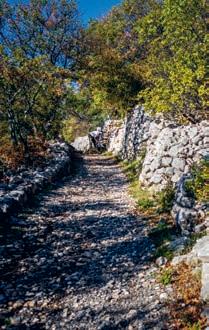
IVO ZANINOVIĆ ON… DRY STONE WALLING
“On Hvar, the dry stone tradition is unique because the entire landscape consists of rocky terrain. Farmers had to extract all the stones from the ground to create fertile soil for cultivation. At the same time, they used these stones to build the incredible walls seen all over the island. Dry stone walls must be preserved as a tribute to the hard work of our ancestors. For us, they are on the same level as the Great Wall of China.
“The best place to see dry stone walls is in Velo Grablje, in the newly opened Dry Stone Park. Here, you’ll find beautiful examples of dry stone terraces and lace-like structures. Beyond the stunning landscape, one highlight is a 111-year-old lime kiln that has been preserved.
“Everyone is welcome to participate by joining a walk through the park or taking part in dry stone walling workshops, especially during Dry Stone Days on Hvar, held once a year in April.
“Visiting Hvar without placing a stone in a dry stone lace wall is like never having been here at all!”
Ivo Zaninović Grande is the president of the Association for the Protection and Revitalization of Velo Grablje
HVAR LACE MAKING
“We have been making lace from agave thread continuously for almost 150 years. The tradition of making lace from agave thread originated in a monastery. One of the unique aspects of our lace-making is that we do not use store-bought thread; instead, the sisters extract and prepare fibres from the agave plant themselves. Since the fibre is natural and delicate, it breaks easily, so lace-making requires patience and precision. When the north wind blows, agave fibres break easily, whereas when the south wind blows and the air is humid, they are much more resilient. It is not easy to make lace during strong northern winds, but we still continue our work.
“The sisters work in silence, prayer and meditation. We also pray for the person who will purchase the lace so that God’s blessing may enter their home. Our focus is not on quantity but on quality and love for the craft. Every sister incorporates something personal into her work, and each of the three lace-making techniques [is most suited to] different sisters. Each sister creates from memory and imagination, which makes every lace piece unique and special.
“Agave lace is an art form and cannot be used for any practical purposes, as it cannot be washed or ironed. As an artistic piece, it is preserved and protected under

glass, and it is usually framed and displayed as a picture on the wall. Visitors can learn more about agave lace at our museum, and can sometimes see part of the lace-making process when one of our sisters works in the museum during the summer months. Our agave lace is exclusively available for purchase at our museum and monastery.
“Preserving and continuing the tradition of agave lace-making is important to us because it is part of our cultural heritage and identity. We are proud of our monastery and the sisters who passed down this unique artistic heritage, and we hope to continue this tradition for future generations.”
Told to us by a spokesperson from the Benedictine Monastery and Church of St Anthony the Abbot, Hvar

The traditions of Hvar (clockwise from left page) Historic Hvar is home to six UNESCO cultural heritages; the best place to see Hvar’s dry stone walls is in the newly opened Dry Stone Park in Velo Grablje; making lace from agave thread has been a part of the monasteries of Hvar for more than 150 years; the sisters of the Benedictine Monastery and Church of St Anthony the Abbot make their lace in silence, prayer and meditation
ANTONIO
ŠKARPA
ON… FOLLOWING THE CROSS PROCESSION
“I’ve been participating in the Za Križen procession since early childhood.The procession passes through six villages on the island of Hvar – Vrboska, Jelsa, Pitve,Vrisnik, Svirče and Vrbanj. I’ve been connected to the village of Vrbanj since birth; it’s where I was baptised. My love for this procession was instilled in me from a young age, mainly thanks to my grandparents, but also my parents.
“I first walked the entire route when I was about eight or nine years old. At the final station, a fellow villager had to carry me because I was so tired. Before that, I participated stage by stage – first walking only to the neighbouring Vrboska, and the next year all the way to Jelsa. As I grew older and my faith in God deepened, my reasons for participating changed. In the beginning, it was about tradition and wanting to be part of something cherished by my loved ones. Today, it’s
a profound spiritual need and a deep sense of gratitude that I carry in my heart.
“The Za Križem procession dates back to the first half of the 16th century, with historical documents confirming its age and continuity. It is a five-century-old devotion centred on the cross, led by a cross-bearer accompanied by torch and candle bearers dressed in white tunics. The deep-rooted nature of the procession in the islanders’ consciousness was evident even during the war year of 1944. Although the procession couldn’t take place on the island that year, refugees from the six parishes held the procession in exile in El Shatt [a refugee camp in Egypt where residents of Dalmatia were evacuated in 1944]. The crosses used in that procession are preserved in the local churches, serving as a lasting reminder of faith and unity.
“Everyone who participates in the procession carries within them a profound sense of responsibility – to ensure everything runs smoothly, to maintain the unbroken chain of

tradition and faith in Christ. It’s as if the original vow to keep this procession alive has been deeply embedded in the collective consciousness of the people, who cannot imagine life without this sacred annual devotion.
“The Za Križem procession is neither a show nor a tourist attraction; it is an all-night journey with Christ and a deeply spiritual experience that invites us to pause, look within, and reflect on who we are as people. It offers a chance to emerge from the night changed and filled with understanding, compassion and greater tolerance for others.
“Everyone is welcome to participate in the procession, whether they come from afar or are local islanders… Anyone wishing to attend should come with an open heart and a respectful spirit. You’ll experience something beyond words, a moment that will stay with you for life, bringing peace, strength and renewed faith in a better tomorrow.”
Antonio Škarpa is the Mayor of the town of Stari Grad

JURICA HRASTE ON… KLAPA SINGING
“Klapa singing is a traditional form of multi-voice singing specific to coastal towns and islands, especially in Dalmatia, although it has spread to other parts of Croatia. A klapa consists of a group of people – usually friends – who come together to sing. They are typically amateurs, but the stronger their bond, the better their performance.
“The term klapa comes from this idea of connection, as members are brought together more by friendship than by vocal skill or formal training. The lyrics are mostly about love, and over time, klapa singing has evolved from a traditional folk practice to a more professional form, incorporating sheet music and expert guidance.”
Jurica Hraste is a member of Klapa Pharia

KRISTIJAN ROJNICA ON… THE MEDITERRANEAN DIET
“My earliest culinary influences weren’t found in professional kitchens but at home, in the warmth of my grandmother’s and mother’s cooking. Both women worked tirelessly from a young age. I found myself stepping into the kitchen not just out of necessity, but out of genuine curiosity and care. Cooking for the family became a daily rhythm and a way to contribute, connect and, eventually, express myself. Those early experiences – learning how to stretch ingredients, season by instinct and respect the time and effort behind each dish – laid the foundation for everything that followed. It was in those formative moments, stirring pots after school or watching dough rise on a sunny windowsill, that my love for cooking truly took root.
“At its heart, the Mediterranean diet is about simplicity and quality. Meals are built around fresh vegetables, fruits, legumes,
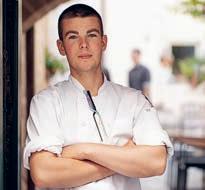
nuts, seeds, whole grains and olive oil – often sourced locally and prepared seasonally. It’s as much about how you eat as what you eat. Meals are traditionally shared with family and friends, enjoyed slowly, and are often accompanied by conversation and, sometimes, a glass of wine. This social element is believed to support both mental and digestive
health. Each region around the Mediterranean – from Dalmatia to Crete to southern Italy – brings its own interpretations and ingredients. Yet they all share a deep respect for food as something seasonal, honest and connected to land and sea.
“At the core of every dish are the ingredients. For me, that means celebrating the best of what Croatia has to offer. I work almost exclusively with fresh, local produce, and I have a particular love for Adriatic fish and raw seafood, which I treat with the utmost respect.
“Wine plays a central role in both pairing and preparation, adding depth and regional identity to each meal. Most importantly, I cook with the seasons. Nature sets the pace, and I believe true creativity lies in responding to what the land and sea provide – not forcing flavours out of context, but elevating them with care, technique and a bit of soul.”
Kristijan Rojnica,
private chef
A taste of Hvar (clockwise from far left) The Za Križem procession dates back to the first half of the 16th century and proceeds through six villages on Hvar; traditional Dalmatian klapa singing is usually performed in groups of between four and ten people, who are typically friends, and is strengthened by the sense of community inherent in these groups; Hvar’s cuisine is a mix of Mediterranean flavours, heavily influenced by the sea and the seasonal produce of the island; Kristijan Rojnica started cooking in his mother’s kitchen, which laid the foundations for his belief that culinary creativity lies in working with the seasons


Slow down in Šibenik
Robin Mckelvie eases into the local pace of life in Šibenik and finds that this history-rich Croatian city is a treat best savoured slowly…
As the boat ploughed the narrow St Anthony’s Channel, I stood on its bow to savour one of travel’s great arrivals. Šibenik reared up ahead, a stone leviathan soaring from the aquarium-clear Adriatic. The twin fortresses of St Michael’s and St John’s still stand sentinel over a Croatian city that the Romans, Greeks and Venetians all failed to conquer. No wonder the producers of the Game of Thrones TV series sought out the grandeur of Šibenik – blessed with not one but two UNESCO World Heritage sites.
BACK IN TIME
Šibenik is one of Croatia’s oldest cities, oozing history and heritage. You feel this depth in the rich civic fabric that bustles
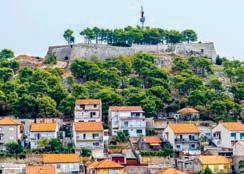


beneath the city’s orange-tiled roofs. You feel it in an Old Town whose tentacles spread through lanes and up a multitude of staircases. One barman I met even proudly insisted that Šibenik boasts more stairs than Dubrovnik – and I firmly believed him. Each corner that I turned revealed ever more drama in a city of myriad layers.
But Šibenik is no staid museum exhibit; it pulses with a palpable Dalmatian swagger. I followed the local example, enjoying a bijela kava (the Croatian latte) on a waterfront made for letting time drift by. Šibenik did slow travel long before the term became fashionable. Life in this sultry Mediterranean city is something to be savoured, not just quickly consumed. Locals even have a word for it: ‘fjaka’, a more mellow version of joie de vivre
– or more like la dolce vita, given the Italian influences that wash in on the tide.
A LIVING MUSEUM
The first of Šibenik’s pair of UNESCO sites that you’ll likely encounter is the Fortress of St Nicholas, which I passed on sailing into the city. The other is the Cathedral of St James, the heart and soul of life here. Nothing prepares you for its intricately carved gleaming stone, or the dome that hangs above it like a saintly halo.
The cathedral was one of the stars of the Game of Thrones TV series, having featured as the Iron Bank of Braavos. Its edifice soars high above the Old Town streets as Europe’s only entirely stone-built cathedral, constructed from interlocking stones – no

Cultural Šibenik (clockwise from bottom left)
Traditional klapa singers; Šibenik’s 16th-century Town Hall; St John’s is the largest of Šibenik’s fortresses; the mighty St James’ Cathedral; an aerial view of St Nicholas Fortress; (previous spread) the best way to arrive here is by water
mortar or wood was used in its creation. It is adorned with 71 stone heads, the identities of which are a source of local debate. I liked the version told to me by one waiter: “They were the heads of people the architects knew. If they liked them, they look good; if not, they made fun of them – set in stone forever.”
This playful streak courses through Šibenik’s solid stone streets and brings life to this living museum of a city. I heard it carried on the strains of a violin emanating from an apartment window, in the giggling kids turning an ancient square into football pitches, in the sunglasses-clad teens posing on their mopeds and in the more mature citizens who whiled the day away playing cards on a sun-dappled bench.
Šibenik offers the best of both worlds: a rich heritage that is easy to access, alongside a modern, living and breathing city that charms you with its life-affirming soul.
I delved under its skin first at the Šibenik City Museum, which has been telling the city’s story since 1925. Next came the Museum of St Francis, which lies in a Franciscan monastery housing one of Croatia’s most important heritage libraries. Here I found the Šibenik Prayer, one of the earliest examples of the Croatian language written in Latin script, dating back to 1375. Other city treasures included the Renaissance glory of the Town Hall and the lavishly Venetian-tinged Republic Square.
Despite the impressive imprint of man, the balm of nature is never far away in Šibenik.

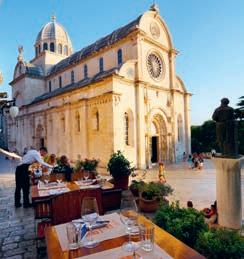
3 cultural highlights of Šibenik
1 The Cathedral of St James
This grand, all-stone UNESCO World Heritage-listed building took over a century to craft. It was the brainchild of Juraj Dalmatinac and Nikola Firentinac: a collage of Gothic and Renaissance styles, topped with an iconic vaulting dome. Look out for the 71 heads that line the exterior, and come to your own conclusion as to whom they represent and why.
2 St John’s Fortress
Šibenik’s largest, highest fortress has loomed some 100m above the city since the 17th century. Hastily erected to repel the Ottoman threat, this starshaped defence has stood the test of time and gone on to star in the TV series Game of Thrones. Re-opened to the public after a revamp in 2022, it also serves a key educational role in this deeply cultural city.
3
St Nicholas’ Fortress
This dramatic fortress at the entrance to St Anthony’s Channel has rightly earned a place on UNESCO’s World Heritage list. Forged on the islet of Ljuljevac in the mid-16th century, it played a key role in guarding the maritime approaches to Šibenik. Today, it is said to be the only surviving Venetian military fortification that is completely surrounded by the sea.

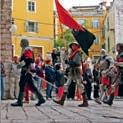

3 ways to meet the local people of Šibenik
1
Etnoland Dalmati
This recreation of a traditional Dalmatian community is as popular with visitors as with Croatians. It celebrates traditional ways of living, but this is no staid museum; its immersive experiences include demos of how locals make the region’s famous prsut ham or how to slow-cook meat peka-style, or distil rakija brandy. Lunch is a must, as is sticking around to catch the Dalmatian folk and dance performances.
2
The Festival City Šibenik is serious about culture, with its myriad festivals a great way of meeting locals. The festivals use Šibenik’s historic buildings and coast as dramatic backdrops. Look out for the Šibenik Dance Festival, Medieval Fair Šibenik, International Children’s Festival and the Evenings of Dalmatian Chansons. Other musical extravaganzas include Terraneo and Salsa Beach Splash Festival.
I retreated to the St Lawrence Church and Monastery, home to a long-abandoned medieval Mediterranean garden that was painstakingly restored in 2007 by landscape architect Dragutin Kiš. Today, it is tended to by students from the city. Sitting in the café – this is Šibenik after all – with the aromas of eclectic flora filling the air was a spirit-soaring joy.
FED BY THE MED
I always savour every day in Šibenik, but sunset is never tinged with sadness, not when another dinner awaits. Šibenik is one of the
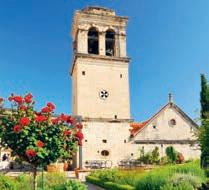
3
Take a local guide Book a local guide, such as Igor at Šibenik Tour, to get under the skin of the city. Igor embraces the slow-travel ethos in a city that is just made for exploring on foot. It is all part of his philosophy: “Allowing you a deeper experience, stronger emotional involvement and relaxation. After all, the Croatian coast is well known for its slow Mediterranean lifestyle, called ‘fjaka’ (pronounced ‘f-ya-ka’).”
Mediterranean’s great foodie cities, weaving Italian, Austro-Hungarian and Turkish influences into a local mix alive with local produce. Boat-fresh seafood is often cooked simply, with olive oil, wine and herbs.
At a humble konoba (a cross between a tavern and a small restaurant), my waiter Goran beamed “Dobar tek” (bon appétit) as I tucked into a delightful Šibenik Bay mussel risotto with a glass of debit wine, a crisp white from a small vineyard around Skradin, finishing off with rožata, a flan-like dessert.
Šibenik was something of a foodie secret until 2019, when chef Rudi Štefans’
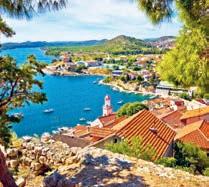

Pelegrini restaurant put the city on the gastronomic map, winning a coveted Michelin star for the first time. The backbone of his modern, creative take on Dalmatian cuisine is built on sound local provenance, such as Adriatic lobster and lamb from the hinterland. The restaurant’s stated aim is to ‘guide you through a gastronomic map of our region’. It achieves that not only on the plate but in the cellar too, with a selection of bone-dry local white wines and tastebud-tingling tannic reds.
I ended my time in Šibenik feeling sadness at having to leave this most beguiling of cities. The water constantly beckoned, with its myriad islands just a short sail away, but I contented myself with a last swim. My refreshing dip came drenched in the drama of hulking fortresses and soaring churches, the unmistakable skyline of one of the Mediterranean’s great – and still often underrated – cities.
Sun city (clockwise from bottom left) The Mediterranean garden Of St Lawrence Monastery is a jewel; festivals are a way to sink into local life; Šibenik Medieval Fair is held in September; a guide helps you get more out of the city; Šibenik is one of few cities to have two World Heritage sites; the city’s food scene is thriving; sailing past St James Cathedral; Vrana is Croatia’s largest lake; there are 89 islands in the Kornati archipelago; Krka National Park; the orange-tiled roofs of Šibenik

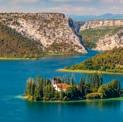
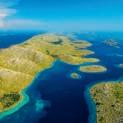

3 ways to escape to nature in Šibenik

Need to know
How to get there and around: A new Šibenik airport is planned, but both Split and Zadar airports offer easy access. There are fast road connections from both cities (and their airports) via bus services. You can travel by rail from Zagreb and Split, with a change of train at Perkovic. Public buses serve the city and its surroundings. Jadrolinija run ferries to the islands (jadrolinija.hr)
When to go: Most tourists are understandably drawn to the long, warm Dalmatian summers, when sea temperatures rise and the city buzzes with life. Savvy visitors, however, should consider coming out of season. Early May and October tend to be cooler and less busy, making it even easier to tap into the local way of life and culture.
1
Krka National Park
Quite simply, one of Europe’s great natural wonders. This 100 sq km lavender-scented oasis of sweeping river and emerald forest includes such highlights as the waterfalls of Skradinski buk and Roški slap, and boat trips out to Visovac Monastery. It’s also great for hiking and biking.
2
Kornati Islands National Park
The 89 islands of Kornati are famous among sailors, who stop off here to swim in the clear waters and savour boat-fresh seafood in the local restaurants. There are also day trips by boat that include a spectacular sail back to Šibenik; you can even book a sightseeing flight.
3
Vrana Lake Nature Park
Croatia’s largest lake is a striking stretch of water created 12,000 years ago. It is only separated from the Adriatic by a thin wall of porous limestone, with fresh and salt water mixing. It’s also an ornithologist’s paradise, with over 260 species of bird spotted around its waters.

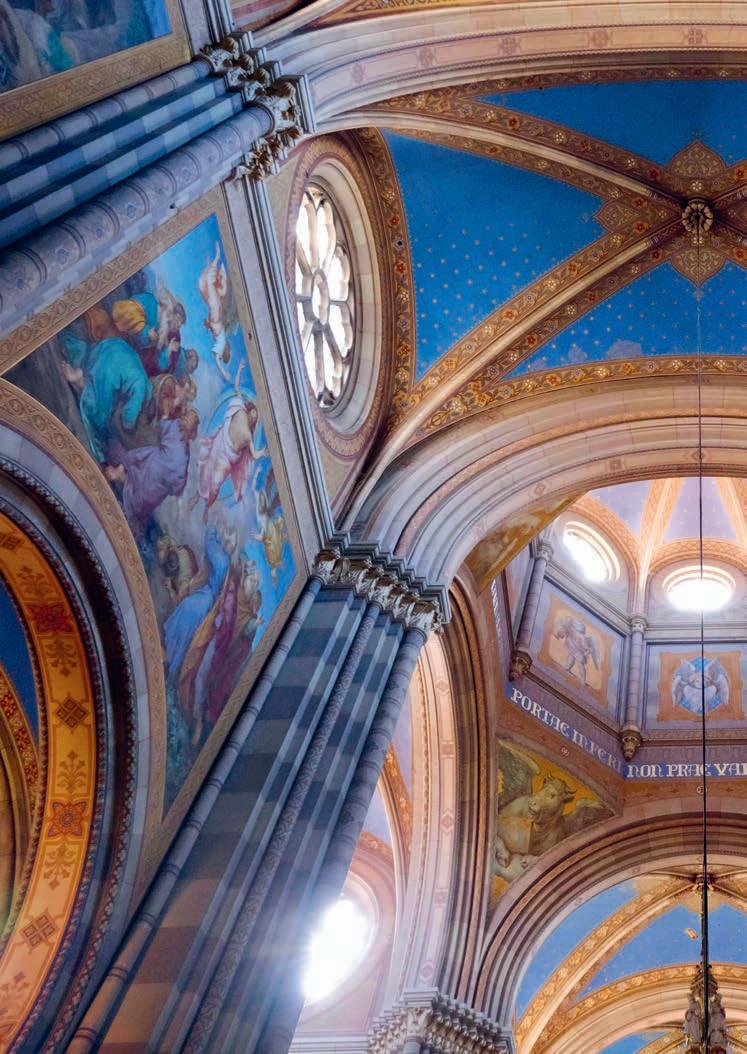
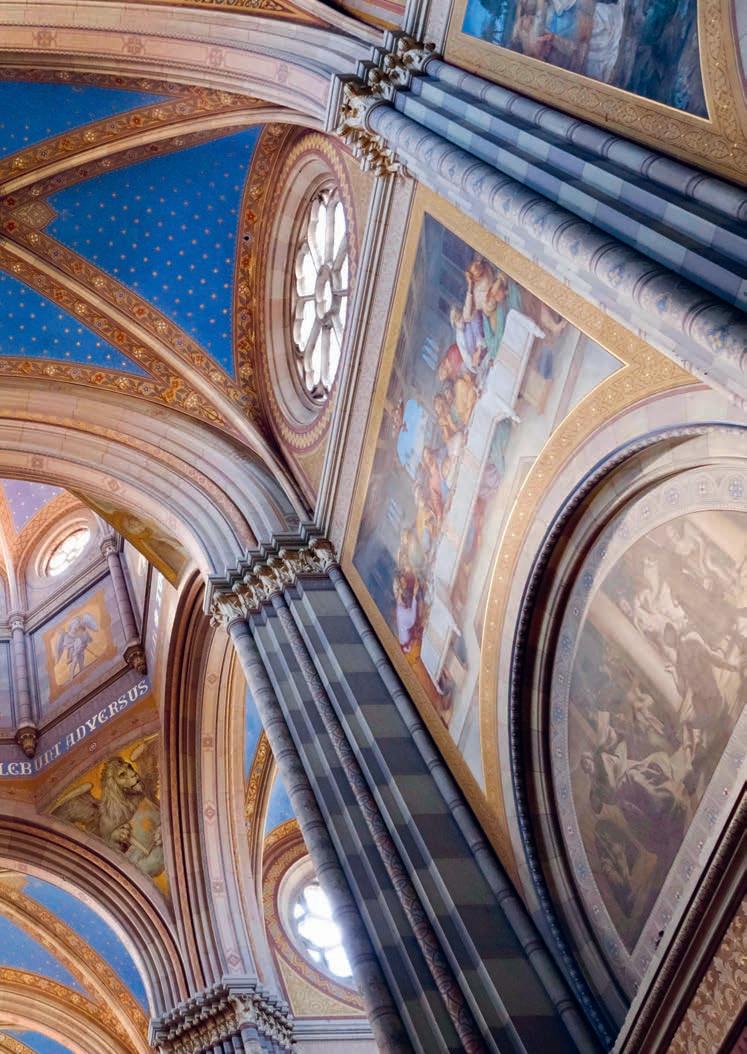
Destination guides
These expert guides delve into some of the lesser-visited corners of the country, not to mention Croatia’s oft-overlooked capital. Discover wild scenery, culture-packed cities and hidden delights far off the tourist beat

An expert guide to…
Zagreb
Mary Novakovich guides us through Croatia’s cool, classy and cultured capital
While many visitors to Croatia bypass its capital and head straight to the Adriatic coast, discerning travellers have cottoned on to Zagreb’s enticing mix of Central Europe with a dash of the Med.
WHY GO?
Croatia’s capital is one of the most appealing in Europe, with a café culture that’s more relaxed than you’ll find in Vienna, combined with a buzzing restaurant scene and seriously cool bars. Between Zagreb’s medieval and baroque Upper Town and stately 19th-century Habsburg-influenced Lower Town, it
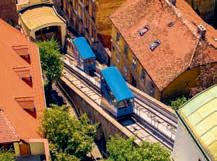
has a compelling collection of museums and galleries wedged among its many restaurants. In this city made for strolling, there are plenty of green spaces where you can stop and watch the world go by. Go hiking and picnicking in Sljeme mountain just outside the city, or chill out on the beach at Lake Jarun.
THE HIGHLIGHTS
Zagreb’s heart is Ban Jelačić Square, a handsome rectangle of pastel-coloured 19th-century townhouses. From here, you’re seconds away from Zagreb’s foodie heart, Dolac market, where trestle tables under bright red umbrellas are filled daily with local produce. Make your way gently uphill to the baroque
buildings of the Upper Town, one of which houses the Museum of Broken Relationships – a poignant and sometimes wryly funny collection of objects signifying lost love.
Get a crash course in the city’s history at the Zagreb City Museum at the top of the Upper Town, and head downhill via vibrant Tkalčićeva Street, a car-free thoroughfare thronging with bars and restaurants.
Back in the Lower Town, join the locals having their daily coffee fix in the cafés of Petar Preradović Square (also known as Flower Square) and under the covered terraces of the bars along neighbouring Bogovićeva Street. You’ll be close to the so-called Green Horseshoe – a U-shaped collection of
eight parks, squares, gardens and monumental buildings, including the yellow 19th-century Art Pavilion in King Tomislav Square.
You don’t have to be a science buff to enjoy the Nikola Tesla Technical Museum in the university quarter. Its somewhat dry-sounding name doesn’t prepare you for the entertaining exhibits, particularly an enormous hangar filled with vintage transport of practically every kind – even a Soviet space capsule.
HIDDEN DELIGHTS
Dolac market is so colourful and the cafés and shops around it are so lively that it’s easy to miss the indoor stalls. Food lovers can check out the butchers, delis and greengrocers, but cheese fans won’t want to miss the room devoted entirely to dairy. Here, you’ll find elderly ladies selling their homemade cheeses and butter.
One of Zagreb’s most up-and-coming districts, the area around Martićeva Street east of Ban Jelačić Square, has been quietly making a name for itself as the city’s latest hip spot. Come here for funky bars, restaurants, delis and homeware shops. Just to the south, in one of Zagreb’s smallest parks, is the Meštrović Pavilion, created by Croatia’s most famous sculptor, Ivan Meštrović. This bold, circular building dating from 1938 is the offi-

cial home of the Croatian Society of Fine Arts and hosts temporary art exhibitions.
In a city of hidden courtyards and stairways, perhaps it’s not so surprising to find a Second World War bomb-shelter tunnel that’s since become a tourist attraction. Grič Tunnel in the Upper Town has six passageways that offer shade on hot days – as well as an atmospheric spot for art exhibitions.
NEED TO KNOW
Zagreb’s funicular is being renovated and will be closed until at least March 2026. The tiny railway, one of the shortest in the world, is


the most picturesque way of getting from the Lower Town to the Upper Town, but you can still go between both districts on foot.
WHEN TO GO
Zagreb is a year-round city with a packed cultural calendar. June is a popular month for festivals, including Zagreb Beer Fest and the IN Music Festival. Things get quieter in July and August when many residents head for the Adriatic, but that’s the time to cool off at Lake Jarun’s beach. Come from late November to early January for the superb Advent market.
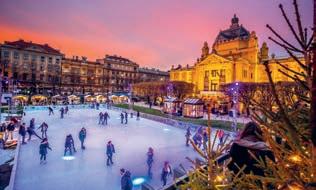


Cool culture (this page; clockwise from top) The Croatian National Theatre is lit up during Zageb’s annual Festival of Lights in March; Croatia’s capital comes alive with Advent events in winter; don’t miss the Museum of Broken Relationships; Dolac Market may be famous for its food but its flower section is also worth exploring; the Nikola Tesla Technical Museum celebrates the work of the great inventor; Tkalčićeva Street bustles with restaurants, shops and bars; (opposite page; top to bottom) the colourful rooftop of St Mark’s church includes regional coats of arms; the Zagreb Funicular is one of the shortest in the world
A first-timer’s guide to…
Međimurje
Međimurje may be way off the tourist radar, but that’s part of what makes it so exciting to explore, as Sara Darling discovers…
The region of Međimurje in northernmost Croatia almost feels as if it has been lifted from the pages of a Tolkien novel, with wildflower-strewn meadows, medieval castles and vineyards that stretch lazily across the landscape. Nestled between the mighty Mura and Drava rivers, it is steeped in local folklore, tradition and ancient legends. It is also criminally overlooked by visitors.
WHY GO?
Međimurje is not a place for ticking off bucket-list landmarks; however, it does boast miles of dreamy scenery. Situated at the crossroads of Central Europe, there are centuries-old traditions, a vibrant slow food culture and mineral-rich thermal waters.
Often dubbed the ‘Garden of Croatia’, organic farm-to-table dining and the ancient
art of winemaking are a part of everyday life here.You can work up an appetite by hiking or biking through the impressive nature reserves, exploring 16th-century fortresses or simply wandering trails alongside the rivers, which play an oversized role in Međimurje’s folklore – through tales of fairies and the Drava monster – before unwinding at one of the region’s mineral-rich spas.
THE HIGHLIGHTS
Međimurje has long been known for its healing waters, and nowhere is this more elaborately realised than at Terme Sveti Martin. Inspired by Rudolf Steiner’s philosophy, the ‘Temple of Life’ indoor pools are bathed in natural light, with panoramic windows that make you feel like you’re floating in the middle of a forest.
Oenophiles will love the Štrigova Wine Roads, a scenic route through rolling
vineyards that spans dozens of wineries and more than 30 tasting houses and cellars. This is the heart of Međimurje’s winemaking culture, where pušipel, the region’s signature white grape, takes centre stage. Other traditions that have stood the test of time are lacemaking, intricate gingerbread houses, pottery and handmade wooden toys.
Elsewhere, the city of Čakovec is currently reinventing itself. Once an industrial hub, it’s now brimming with fresh energy and a mix of old-world charm and new creativity. The Stari Hrast Pub, housed in a former factory, serves craft beer brewed on-site, which is perfect for a laid-back introduction to the region’s emerging beer scene. From there, a short stroll leads you to Čakovec Castle (Zrinski Castle), a magnificent Renaissance fortress steeped in history. This once belonged to the powerful Zrinski family; today it houses the Međimurje



County Museum, where you can learn about the region’s intriguing folklore.
HIDDEN DELIGHTS
Međimurje is full of hidden gems, ranging from traditional working mills and underground wine vaults to ancient forests and thermal springs. Take a step back in time at one of the last-remaining floating mills in Central Europe. Suspended over the Mura River, the mill continues to grind grain into flour just as it did centuries ago – and visitors can even buy some to take home!
From here, take a leisurely stroll along the Miller’s Path, which winds past a stunning oxbow lake covered in blooming water lilies. Known locally as mrtvica (‘dead stream’), it is actually remarkably full of life.
Learn about local folk traditions at Ethno House Međimurski Dvori. This charming estate is a step back in time and features hand-embroidered costumes, antique tools and traditional wooden houses, meaning visitors can explore how life once looked.
Whilst Terme Sveti Martin may be the most well-known spa here, the Vučkovci Spa, dating back to 1936, is another gem and is ideal for those seeking relaxation in a quieter setting. For a truly immersive wine
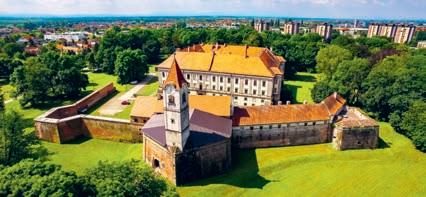

experience, visit Terbotz Manor House in Železna Gora. Here you’ll find a museum-like wine cellar that showcases bottles from across Međimurje. Book a tasting in their atmospheric surroundings and enjoy the impressive vineyard view.
NEED TO KNOW
While card payments are widely accepted in cities, rural areas often prefer cash, and uttering a “Hvala” (thank you) or a “Molim” (please) goes a long way.You may be offered Međimurska rakija as a welcome drink; it is an offer worth accepting, as this potent brandy is delicious! Keep an eye out too for ‘black gold’, a tasty local pumpkin seed oil that is drizzled over salads, cheeses or warm bread.
WHEN TO GO
Wine lovers will have the best time in Međimurje in the second half of May. This is when – across three consecutive weekends – the wine festival Urbanovo takes place, offering plenty of tastings and chances to meet those behind the wines. Spring and autumn are ideal for experiencing the great outdoors without the heat.Winter is ideal for a cosy spa escape, when you can enjoy thermal springs and hearty zlevanka (sweet cornbread).

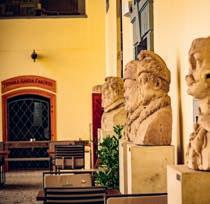
Green, green valleys (this page; clockwise from top left) Međimurje is known as the ‘Garden of Croatia’ for its rolling greenery and fertile soils; Čakovec (Zrinski) Castle was the scene of a failed 17th-century plot to oust the Habsburgs from Croatia and Hungary; Međimurje’s observation tower features an organ at the top which is operated by the wind; the floating mill on the Mura river contains the mill’s original mechanism from 1902; Čakovec Castle was the family home of the Zrinski dynasty; Međimurje is wine country; (opposite page) hot air balloon rides over Međimurje offer views of the region’s landscape

A beginner's guide to…
Gorski Kotar
This natural wonderland is little known to visitors despite its wild scenery, walking opportunities and wonderful emptiness, finds Richard Mellor…
There’s a good reason why Gorski Kotar is nicknamed the ‘green lungs of Croatia’: more than 80% of it is forested. Beginning only a few miles inland from the south-westerly Kvarner Riviera near Rijeka, this sprawling, untouched region is also a realm of mountains, canyons, rivers and lakes — and one where, according to the latest census, there are just 15 inhabitants per square kilometre.
WHY GO?
Factor in the scarcity of tourists, too, and you’re guaranteed that most precious of holiday commodities: an authentic expe -
rience. Gorski Kotar has plenty to delight active and slow travellers alike, from mountain climbing, hiking, cycling and kayaking to gentler-paced bear-watching, birdwatching or fishing.
Foodies may wish to investigate its hearty, forest-based cuisine, while culture lovers gravitate towards castles and an ancient monastery. A final reason to visit, especially in summer, is to escape the Adriatic Sea’s heat – even if merely day-tripping.
THE HIGHLIGHTS
The western half of Gorski Kotar is anchored upon rugged Risnjak National Park, named after the tallest of its snow-capped moun-
tains. Dense forests are the norm here, supporting Europe’s three biggest carnivores in lynx, wolves and brown bears – with two remote log cabins available for overnight stays and offering a good chance of watching the latter, especially in winter.
Trekkers can ascend to Risnjak’s 1,528m summit, with some scrambling required, while another well-marked path from the same starting point in Crni Lug offers a much gentler three-mile forest loop. Also inside the national park is the Kupa River’s large spring: a brilliantly turquoise pool found on a steep downhill path near Razloge. South of here are three winsome reservoirs with plunging, verdant flanks and the
Alamy; Alan Čaplar; Bojan-Haron Markičević; Maja Danica Pečanić; Zoran Jelača
potential for canoeing and windsurfing (Lake Bajer) and fishing (Lake Lepenica and Lake Lokve). Arguably even more photogenic, however, is the Devil’s Passage.
Slightly northeast of red-roofed Delnice, Gorski Kotar’s main town, this lovely canyon connects Zeleni Vir, a wispy waterfall, with the deep, water-filled cave of Muževa Hižica where locals once hid from invading Ottomans. Enframed by sheer rock faces up to 100m high, this stunning, shady ravine is almost a kilometre long and yet barely a couple of metres wide in places; steps and planked walkways take walkers up it.
HIDDEN DELIGHTS
Skrad, a nearby town, is on the old Lujzijana Cesta (Louisiana Road), an early 1800s trade route between Karlovac and Rijeka built while the area was under Napoleonic rule. Mostly forming today’s D3 state route, it makes for a splendid drive past timber-accented villages and magnificent vistas.
As well as some old 19th-century milestones, look out for older manorhouse-style castles built for the powerful Frankopan and Zrinski noble families, such as Severin na Kupi’s 16th-century construction with its pointy cylindrical turrets. Turn off before Severin na Kupi and


head for Gomirje to find Europe’s westernmost Serbian Orthodox monastery. Once another Frankopan castle, the lemon-hued Gomirje Monastery was first established in 1600. Nearby is another fairytale canyon, the Kamačnik, with its wooden bridges and cascades.
South of here, on Gorski Kotar’s easternmost margins, sprawls the far-flung Bijele i Samarske Stijene nature reserve, named for a collection of perpendicular, bone-white rocks which rise from ravines with permanent snow in their depths. It’s a great hiking area – as is the rather gentler Golubinjak Forest Park, back towards Delnice.
Here, along with oak sculptures by a local art colony, walking trails lead to the Queen of the Forest, a giant silver fir tree estimated to be 250 years old.
NEED TO KNOW
The gastronomy here is distinct in Croatia. Lamb, beef and pork proliferate, often in stews with pickled cabbage and beans, alongside mushrooms and forest berries. Be sure to sample the region’s bitoraj (blueberry strudel). Accommodation-wise, choose between good hotels in towns like Delnice and the area’s mass of more rural rental homes. Warm hospitality is a given throughout.

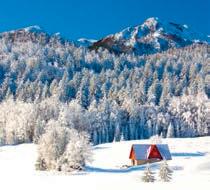
WHEN TO GO
Winter, as snow covers Gorski Kotar’s mountains, is best for bear-spotting. Spring and autumn provide peak hiking conditions, with the latter also seeing the forests’ many beech and oak trees turn thrilling shades of red and gold as mushrooms appear. Spring, in comparison, promises wild flowers and rushing waterfalls. Summer’s the time when you might hear wolves howling, and it’s a great bet for gentle rambles or refreshing lake swims.


Wild beauty (opposite page) Ascend to the summit of Veliki Risnjak for views over the rugged peaks and forests of Gorski Kotar; (this page, clockwise from top left) the peaceful forests offer good bear-spotting opportunities; a hearty dish of lamb, potatoes and vegetables cooked in the traditional peka style; the rock formation at Zeleni Vir near Skrad has water cascading from its peak; the white karst limestone cliffs of Bijele i Samarske Stijene reach elevations of up to 1,300m; winter in Gorski Kotar creates a magical landscape; forest trails lead to pools, springs and canyons in Risnjak National Park

Alamy; Saša Pjanić; Filip Beusan
A cultural guide to…
Slavonia
Easternmost Croatia captivates with its slow food scene, historic towns and villages, and its sprawling wetland which gives life to much flora and fauna, as Sara Darling uncovers…
Tucked away in Croatia’s easternmost corner, Slavonia is a well-kept secret. After experiencing its mosaic of golden fields, award-winning vineyards and the legendary Black Slavonian pig which feasts on acorns to give its meat a rich, nutty depth, you can finish off your adventure in one of the many thermal spas.
WHY GO?
Don’t expect glittering nightlife in Slavonia – it is all about slowing down, soaking in breathtaking landscapes and indulging in Croatia’s celebrated food and wine scene. Osijek is a quirky medieval city which blends baroque charm with an up-and-coming craft beer scene; whilst picturesque Vinkovci is home to some of the country’s
most immersive traditional festivals. The dramatically named Vukovar boasts history and elegance, and the must-see restored Eltz Palace is now a delightful town museum.
Kopački Rit is pure magic for nature lovers; a sprawling wetland where herons glide, deer dart and rare birds glide through the reeds. Alternatively, hire a kayak and take a slow drift down the Drava, Sava or Danube rivers, where the scenery unfolds at a delightfully leisurely pace.
THE HIGHLIGHTS
The beating heart of Slavonia is the lively university city of Osijek. Stroll along the Drava River promenade and spot white storks nesting in the trees, or climb the majestic Osijek Cathedral – a neo-Gothic masterpiece and one of the tallest churches
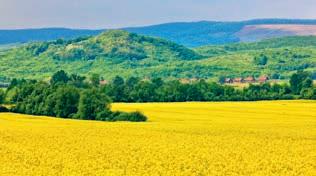

in Croatia, before wandering through the grand baroque streets of Tvrđa – the historic fortress district, where pastel-hued buildings, cosy cafés and wine bars tempt you to stop and linger.
In contrast, the Baranja region is a rustic gem with a slower pace, known for its traditional fishing villages and unique fusion of Hungarian, Serbian and Croatian influences. Sample local specialities like fish stew and čvarci (crispy pork fat); or if you’re feeling thirsty, head over to Ilok, which is famed for its long winemaking tradition. It’s home to several medieval wine cellars serving the famous, aromatic Traminac (Gewürztraminer) which was even served at Queen Elizabeth II’s coronation.
Who knew that Slavonia had beaches? The teeny town of Draž is known as the
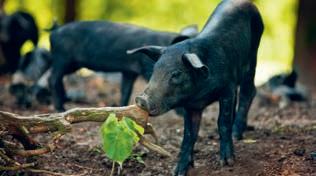

Well-kept secrets (clockwise from left) The Holy Trinity monument in Tvrđa, Osijek’s historic district, was built to defend against plague and has statues of saints around its base; the Slavonia countryside is known for its patchwork of fields and award-winning vineyards; the black Slavonian pig is raised in Slavonia’s forests and feasts on acorns; the landmark spire on the Neo-Gothic Co-cathedral of St Peter and Paul in Osijek is 94m high; Slavonia is ideal for horse riding



plenty of cosy cafés
Maldives of Baranja! On the banks of the Drava near Osijek, you’ll find the popular Copacabana beach; or hop on a boat to the Island of Vukovar, which becomes an openair cinema during the annual film festival.
For anyone with an appreciation of horses, the Đakovo State Stud Farm is home to the majestic Lipizzaner breed. The town hosts the Lipizzaner Jubilee every June, which is a unique opportunity to witness these majestic animals in action, while they showcase their extraordinary skills in dressage and dancing.
Slavonia’s culinary traditions shine in November, when Čvarakfest, a winter fair in Karanac, celebrates the region’s love of cured meats and traditional dishes.
Whether you’re savouring a glass of graševina in a centuries-old wine cellar, watching Lipizzaners in action, or drifting down the Danube, Slavonia invites you to slow down and savour the beauty of Croatia’s best-kept secret.
HIDDEN DELIGHTS
Throughout the year, small villages put on big celebrations. One of the most memorable is the Spring Festival of Queens in Gorjani, which hosts an impressive carnival to celebrate the Procession of Ljelje. It
takes place on Pentecost Sunday every year; expect traditional costumes, harmonious tamburaška music, lots of food and dancing.
Other customs can be uncovered in Karanac’s Ethno Village, a living museum of Slavonian life. With authentic wooden houses, open-hearth kitchens and homemade delicacies such as štrukli (savoury pastry), fresh cheeses and locally sourced meats, it is a step back in time. Close by is the tranquil, man-made Lake Borovik which boasts a picture-perfect location for a dip, surrounded by dense forests and scented flowers.
In the heart of Slavonia, Ružica Grad is an impressive castle standing on a steep rock surrounded by the Papuk forest. Since the origin of the medieval structure remains unknown, it has become the stuff of legend over the years. Folklore says it used to be the meeting place of fairies, which locals are happy to confirm over a cold beer in the town.
The quiet village of Orahovica is home to some of Slavonia’s best-kept wine secrets, with family-run vineyards producing fine wines like the Grk variety. Alternatively, the Baranja Wine Route offers a hidden gem of Croatia’s wine culture, with small, family-owned wineries offering a chance to taste wines such as graševina, frankovka, and cabernet sauvignon,
along with regional specialities like vinski vina (wine-based brandy).
Although close to Kopački Rit, Osijek is still considered somewhat off the tourist trail. Home to Austrian nobles in the 18th century, it is spliced by the River Drava and defined by its baroque architecture, riverside promenade and elegant mansions.
NEED TO KNOW
Public transport is limited, so renting a car is the best way to explore the region. Bear in mind that most shops are closed on Sundays apart from larger supermarkets and tourist shops. Don’t forget to try fiš-paprikaš (fish stew with paprika) and tipping at 10% is welcomed.
WHEN TO GO
There is no best time to visit. Spring brings blossoming landscapes and the start of the wine harvest, and the mid-teen temperatures are perfect for hiking. Summer brings sunflower fields and outdoor activities like boating, birdwatching and cycling. In September, you can sample the local wine varieties at the annual Ilok Grape Harvest Festival. Winter brings cosy Christmas markets, festive decorations and a warm, traditional atmosphere across the region.
Colour and character (clockwise from top left) The impressive Tvrđa star fortress sits on the bank of the Drava River in the historic area of Osijek city, which was home to Austrian nobles in the 18th century; young girls in their colourful costumes prepare for the spring procession as queens in the village of Gorjani on Pentecost Sunday; Tvrđa is the oldest part of Osijek, with old paved streets, fountains and monuments to admire, plus
and wine bars to linger in during your visit


Croatia is a land that rewards travellers who head off the beaten path. This special edition is packed with ideas and stories that reveal its hidden corners, inspiring authentic and immersive adventures across a country that is never short of surprises… or a tale to tell.
